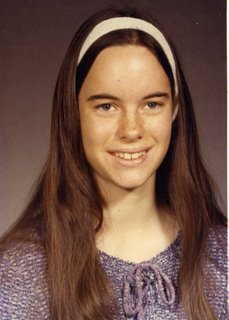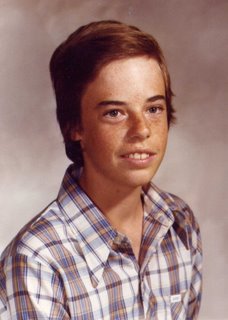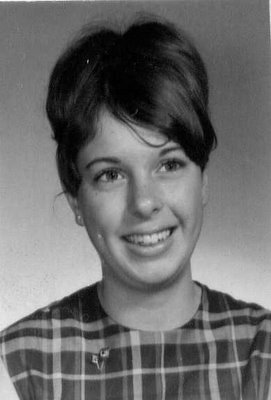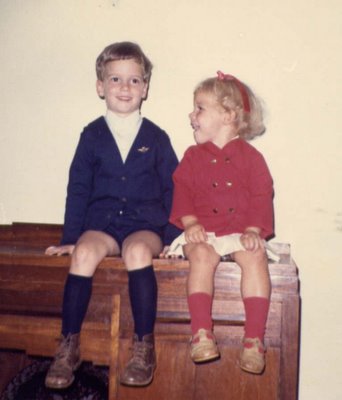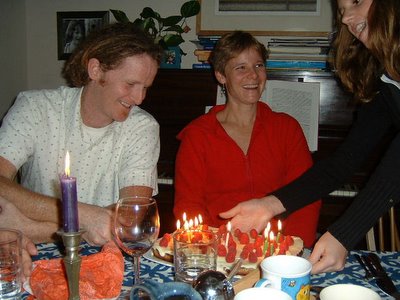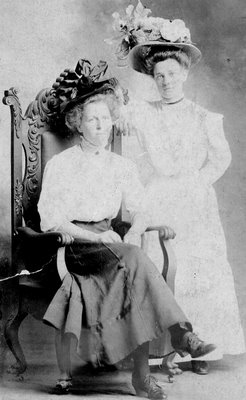Judy and Marty


Judy and Marty and Leah and Riley
by Judy Henderson
In 1985, my father sold the farm in Brome. This was the Henderson’s country get away since 1966. I actually feel that I grew up at the farm. It had all the things I loved: Skiing, Horses, Farming, Friends. Country life was something I grew to love and while growing up in Brome I knew I would always live in the area.
Eventually my love for horses lead me to college for equine studies and for some time I worked as a horse trainer and became a riding instructor. When my father sold the farm, it was heart breaking for me. When we left there, I was sure I would never go back, it would be too difficult. It was like leaving a good friend. Anyway, I moved on and found a new place to keep my horses and a few years later I rented my own little place on Brome Lake.
In 1991, I started a new job working in sales in transportation and customs brokerage and spent time with horses and gave riding lessons to various people as a side line. In August 1993 a student who I had taught for some time over the years, but then lost touch with, called me. Stephanie asked me if I could meet her, and evaluate her and her new horse. She wanted to go in a horse show, but was not sure she would have time to prepare. She wanted me to help get her ready. I agreed to meet her. Stephanie then gave me the address. It was our old farm! I was shocked and quite hesitant at first. Then with something stuck in my throat I told her I would be there. Ouch!
The day came and I drove down that driveway with such apprehension. I arrived at the barn with my little dog, " Prancy" in the back wagging her tail whining with excitement. Of course ! She was elated to be back. This was her home too! I walked into the barn, looking for my student. This was hard because everything was the same as it was. My old stable! I then met up with Stephanie’s boy friend, Mike. Mike told me to go out to the riding ring and I would find her there. So, I went out to my old riding ring where I had taught so many lessons and trained many horses. There at ring side, stood a very handsome young guy, Marty! Well, that is when I met Marty.
My student then, Stephanie, is now a very close friend who has two horses in my stable in Fulford. Her daughter Allison is very good friends with our daughter, Leah. Allison is like Leah’s big sister. They ride together and share in their love of horses.
We look back on that day and remember the farm and not only did my friend Stephanie bring Marty and I together, but my old farm was the place we met!
Marty and I soon moved in together and then we bought our small house in Fulford in October of 1995 . I became pregnant in 1997 and Leah Renee Lavoie was born Sept 18, 1997. Because I would be 40 in 2001, I wanted to have our second child soon. I did not want to wait So I became pregnant in 1999 and Riley Andrew Lavoie was born Feb 7th 2000.
They are both is school at Knowlton Academy, which is an English School but progressing to be a Bilingual School. They do many subjects in French. They are both fluent in French as Marty speaks French to them, and I speak English.
They do well is school and have a lot of friends.
Riley has become quite the little hockey player. He and his father enjoy this sport together. Marty is on the team of coaches and they travel around to tournaments. They watch the Montreal Canadians with passion, and whenever possible Marty takes Riley to a game in Montreal. Riley is a very good soccer player as well. It is a lot of fun to watch.
Leah’s big passion in life is Gymnastics. She started this when she was in grade 1 and since then, she has excelled in the sport. She does 7 hours of practice in a week. She is a member at a local Gymnastics Club in Granby and she participates in competition and has many medals hanging in her room.
Leah and I enjoy the horses together. Leah has a horse too. She competes as well and really loves it.Saturday, January 10, 2009
Essay on the Generations
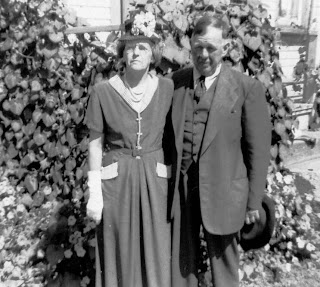
This essay is a bridge between the Henderson generations, between the family of six brothers and sisters all born in that small farm house in Groveton and the next generation, their children.
As I was transcribing George’s letter, I realized both how tenuous life is and how accidental is birth. If those two people had not met at a book club in the early part of the last century, none of us would be here. And since I was born when my mother was 44 years old, a good eight years after my nearest sister, I suppose I was at best an after thought, at least an accident. The good part was that I had sisters old enough to "mother" me and relieve mother from some of the care.
The Cummings Family lived on a farm which backs onto the farm where Margaret Cummings came to live after the wedding to William. They were born, lived, loved and raised their children, all within a radius of 10 kilometers. And their children and their children have spread far and wide.
Now my generation of Hendersons is dissolving with both brother Ray and sister Dorothy gone as I write this in 2009. So far this history has been about this generation, but it is time to start on the next level.Friday, January 09, 2009
George's Letter

Some time ago, George mailed me a letter containing some legal documents related to the farm, including the deed. It is an historical document covering the period when our father and mother bought the farm from Adam Henderson, our grandfather, to when they sold it. George makes several comments in his letter which are well worth reading.
George writes: Enclosed are a sack of legal documents pertaining to the farm. Some of these documents go back to 1910. They tell of a very tough struggle for our father and mother to go through to try paying for the farm and raise a hungry gang of six, and to hang in there and keep on going. I think they had a lot more courage and stamina than today’s citizens.
The Farm:This is somewhat of a puzzle, but the way I read it is that Thomas Baker died in October 1903 and left his will giving Minor Baker, his son, part of the farm provided he support Mary Baker, his widow, for life, and Amanda Baker until marriage or death, if she did not marry.
It was also in his will that the other part of the farm was to be sold to Adam Henderson for $600 with the money going to Minor Baker, and that they must turn over the land part described in the will to Adam without any fuss.
It looks as if Thomas left the part of the farm to Adam and Adam took possession on Thomas’ death. Now Adam owned all of the farm.
Adam sold the farm to our father for $2000 and took back a mortgage of $1000. But our father didn’t have the $1000, so he took out another mortgage of $1000, which adds up, eh? This sounds easy, but this mortgage was with John Jennings who was one of two brothers who lived a concession north of Groveton about two miles away. I can remember him pestering my father regularly. He ran a shoemaker shop in Spencerville and drove a horse and buggy going right past our house every day.
How convenient to stop in and say, "Hello. Oh, by the way, Bill..." "Sorry, no. I don’t have that much, but maybe next week."
Adam, of course, became very ill and died at our house where mother had cared for him for some time. In his will he gave everything to our father. That was in 1924.
He had a horse and buggy, and before he became too ill, he would drive Ray and I to the ball games. We would be about 4 and 6 years old at that time.
He was separated from his wife who lived in Moose Jaw, Saskatchewan –about the right distance my father used to say. She was sister of Albert McQuade and not very popular as I understand.
Our father was a kind and great man and a hard worker. It took our mother to provide the glue that held things together. They both deserved Gold Medals to provide for a family of six.
God bless them. I think of them often.
Judy and Marty


Judy and Marty and Leah and Riley
by Judy Henderson
In 1985, my father sold the farm in Brome. This was the Henderson’s country get away since 1966. I actually feel that I grew up at the farm. It had all the things I loved: Skiing, Horses, Farming, Friends. Country life was something I grew to love and while growing up in Brome I knew I would always live in the area.
Eventually my love for horses lead me to college for equine studies and for some time I worked as a horse trainer and became a riding instructor. When my father sold the farm, it was heart breaking for me. When we left there, I was sure I would never go back, it would be too difficult. It was like leaving a good friend. Anyway, I moved on and found a new place to keep my horses and a few years later I rented my own little place on Brome Lake.
In 1991, I started a new job working in sales in transportation and customs brokerage and spent time with horses and gave riding lessons to various people as a side line. In August 1993 a student who I had taught for some time over the years, but then lost touch with, called me. Stephanie asked me if I could meet her, and evaluate her and her new horse. She wanted to go in a horse show, but was not sure she would have time to prepare. She wanted me to help get her ready. I agreed to meet her. Stephanie then gave me the address. It was our old farm! I was shocked and quite hesitant at first. Then with something stuck in my throat I told her I would be there. Ouch!
The day came and I drove down that driveway with such apprehension. I arrived at the barn with my little dog, " Prancy" in the back wagging her tail whining with excitement. Of course ! She was elated to be back. This was her home too! I walked into the barn, looking for my student. This was hard because everything was the same as it was. My old stable! I then met up with Stephanie’s boy friend, Mike. Mike told me to go out to the riding ring and I would find her there. So, I went out to my old riding ring where I had taught so many lessons and trained many horses. There at ring side, stood a very handsome young guy, Marty! Well, that is when I met Marty.
My student then, Stephanie, is now a very close friend who has two horses in my stable in Fulford. Her daughter Allison is very good friends with our daughter, Leah. Allison is like Leah’s big sister. They ride together and share in their love of horses.
We look back on that day and remember the farm and not only did my friend Stephanie bring Marty and I together, but my old farm was the place we met!
Marty and I soon moved in together and then we bought our small house in Fulford in October of 1995 . I became pregnant in 1997 and Leah Renee Lavoie was born Sept 18, 1997. Because I would be 40 in 2001, I wanted to have our second child soon. I did not want to wait So I became pregnant in 1999 and Riley Andrew Lavoie was born Feb 7th 2000.
They are both is school at Knowlton Academy, which is an English School but progressing to be a Bilingual School. They do many subjects in French. They are both fluent in French as Marty speaks French to them, and I speak English.
They do well is school and have a lot of friends.
Riley has become quite the little hockey player. He and his father enjoy this sport together. Marty is on the team of coaches and they travel around to tournaments. They watch the Montreal Canadians with passion, and whenever possible Marty takes Riley to a game in Montreal. Riley is a very good soccer player as well. It is a lot of fun to watch.
Leah’s big passion in life is Gymnastics. She started this when she was in grade 1 and since then, she has excelled in the sport. She does 7 hours of practice in a week. She is a member at a local Gymnastics Club in Granby and she participates in competition and has many medals hanging in her room.
Leah and I enjoy the horses together. Leah has a horse too. She competes as well and really loves it.
Saturday, January 10, 2009
Essay on the Generations

This essay is a bridge between the Henderson generations, between the family of six brothers and sisters all born in that small farm house in Groveton and the next generation, their children.
As I was transcribing George’s letter, I realized both how tenuous life is and how accidental is birth. If those two people had not met at a book club in the early part of the last century, none of us would be here. And since I was born when my mother was 44 years old, a good eight years after my nearest sister, I suppose I was at best an after thought, at least an accident. The good part was that I had sisters old enough to "mother" me and relieve mother from some of the care.
The Cummings Family lived on a farm which backs onto the farm where Margaret Cummings came to live after the wedding to William. They were born, lived, loved and raised their children, all within a radius of 10 kilometers. And their children and their children have spread far and wide.
Now my generation of Hendersons is dissolving with both brother Ray and sister Dorothy gone as I write this in 2009. So far this history has been about this generation, but it is time to start on the next level.
Friday, January 09, 2009
George's Letter

Some time ago, George mailed me a letter containing some legal documents related to the farm, including the deed. It is an historical document covering the period when our father and mother bought the farm from Adam Henderson, our grandfather, to when they sold it. George makes several comments in his letter which are well worth reading.
George writes: Enclosed are a sack of legal documents pertaining to the farm. Some of these documents go back to 1910. They tell of a very tough struggle for our father and mother to go through to try paying for the farm and raise a hungry gang of six, and to hang in there and keep on going. I think they had a lot more courage and stamina than today’s citizens.
The Farm:This is somewhat of a puzzle, but the way I read it is that Thomas Baker died in October 1903 and left his will giving Minor Baker, his son, part of the farm provided he support Mary Baker, his widow, for life, and Amanda Baker until marriage or death, if she did not marry.
It was also in his will that the other part of the farm was to be sold to Adam Henderson for $600 with the money going to Minor Baker, and that they must turn over the land part described in the will to Adam without any fuss.
It looks as if Thomas left the part of the farm to Adam and Adam took possession on Thomas’ death. Now Adam owned all of the farm.
Adam sold the farm to our father for $2000 and took back a mortgage of $1000. But our father didn’t have the $1000, so he took out another mortgage of $1000, which adds up, eh? This sounds easy, but this mortgage was with John Jennings who was one of two brothers who lived a concession north of Groveton about two miles away. I can remember him pestering my father regularly. He ran a shoemaker shop in Spencerville and drove a horse and buggy going right past our house every day.
How convenient to stop in and say, "Hello. Oh, by the way, Bill..." "Sorry, no. I don’t have that much, but maybe next week."
Adam, of course, became very ill and died at our house where mother had cared for him for some time. In his will he gave everything to our father. That was in 1924.
He had a horse and buggy, and before he became too ill, he would drive Ray and I to the ball games. We would be about 4 and 6 years old at that time.
He was separated from his wife who lived in Moose Jaw, Saskatchewan –about the right distance my father used to say. She was sister of Albert McQuade and not very popular as I understand.
Our father was a kind and great man and a hard worker. It took our mother to provide the glue that held things together. They both deserved Gold Medals to provide for a family of six.
God bless them. I think of them often.
Dorothy and Mac's Wedding
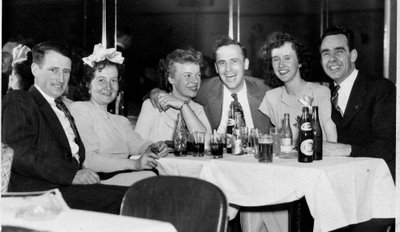
Dorothy and Mac were married in St. John the Divine Chapel, Verdun, on March 18, 1948. The witnesses to the wedding met with the newly weds at the Empress Restaurant in Montreal for an after wedding dinner.
.
In the photograph, on the left are Betty Chambers and Tim Linester, and on the right of the photo are Margaret and Jim Connington.
.
Why is that man laughing?
Friday, March 10, 2006
Thursday, March 02, 2006
Jim Knox: Military Career
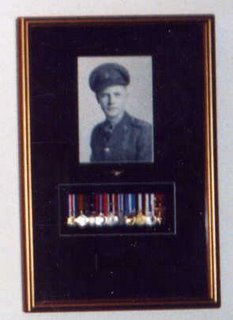

JIM KNOX:
MILITARY SERVICE RECORD 1937-1982
.
This is a summary of a detailed document written by Jim.
This is a summary of a detailed document written by Jim.
.
Jim attempted to enlist in the Finnish army in 1938 when he was 16 years of age, but he was refused. He tried again with the Rainbow Division in 1938, but they wouldn’t have him and that ended his career in the Spanish Civil War before it started.
Jim attempted to enlist in the Finnish army in 1938 when he was 16 years of age, but he was refused. He tried again with the Rainbow Division in 1938, but they wouldn’t have him and that ended his career in the Spanish Civil War before it started.
.
However, his determination to join the army succeeded when he joined the Midland Regiment Militia at 16 and attended summer camp. In the summer of 1939, the Midland Regiment was ordered to Trenton to guard the airfield. As Jim says, "It was great fun for a 17-year-old fanatic." His mother forced him back to school in Bowmanville in September, but he avoided school by enlisting in the regiment when it was mobilized to active service because of the war.
However, his determination to join the army succeeded when he joined the Midland Regiment Militia at 16 and attended summer camp. In the summer of 1939, the Midland Regiment was ordered to Trenton to guard the airfield. As Jim says, "It was great fun for a 17-year-old fanatic." His mother forced him back to school in Bowmanville in September, but he avoided school by enlisting in the regiment when it was mobilized to active service because of the war.
.
At a posting to Edmonton in 1942, volunteers were required for a secret mission out of the country, for which Jim volunteered naturally –along with everyone else. His name was not drawn from the hat, luckily it turned out, since 100 soldiers were dispatched to Hong Kong to protect the British colony and all 100 were killed or captured by the Japanese.
At a posting to Edmonton in 1942, volunteers were required for a secret mission out of the country, for which Jim volunteered naturally –along with everyone else. His name was not drawn from the hat, luckily it turned out, since 100 soldiers were dispatched to Hong Kong to protect the British colony and all 100 were killed or captured by the Japanese.
.
Finally in 1942 Jim boarded the troop ship Andes in Halifax on his way to join the SDG Highlanders in England. Among the thousands of troops on board he met his German teacher from Bowmanville High School. He and his buddies were transported by train from Liverpool to Crookam Crossroads, a one-pub village. During the intensive training that followed, Jim noticed that soldiers running with huge heavy packs and sweating like mad. He also observed one group around a large weapon that required a motorized universal carrier to transport it. It was at that point that Jim decided to become a mortar man.
Finally in 1942 Jim boarded the troop ship Andes in Halifax on his way to join the SDG Highlanders in England. Among the thousands of troops on board he met his German teacher from Bowmanville High School. He and his buddies were transported by train from Liverpool to Crookam Crossroads, a one-pub village. During the intensive training that followed, Jim noticed that soldiers running with huge heavy packs and sweating like mad. He also observed one group around a large weapon that required a motorized universal carrier to transport it. It was at that point that Jim decided to become a mortar man.
.
He was returned to Brockville in Canada for officer training and headed back over on the Ile de France in 1944 as a first lieutenant, a better trip by far than his first one.
He was returned to Brockville in Canada for officer training and headed back over on the Ile de France in 1944 as a first lieutenant, a better trip by far than his first one.
He fought in Belgium as a mortar officer and had some scary moments, but the war ended in 1945 as the regiment crossed the Ems River to Evidon in Germany. They moved back to Holland to guarantee that the Germans returned to Germany without incident.
.
After returning to Canada, Jim was posted to Brockville where destiny brought him and Madeline together. They were married on October 19,1946 in St. Andrews Presbyterian Church in Spencerville with the reception at Madeline’s parents’ home in Groveton.
After returning to Canada, Jim was posted to Brockville where destiny brought him and Madeline together. They were married on October 19,1946 in St. Andrews Presbyterian Church in Spencerville with the reception at Madeline’s parents’ home in Groveton.
.
After leaving the armed forces, Jim went back to school and finished his high school. Jim worked at a few jobs, but re-enlisted in July 1947 joining the RCR as a Sergeant. He earned his private pilot’s licence and later took paratroop training in Rivers, Manitoba just about the time Doug was born in 1948. He was promoted in the next few years to lieutenant and then to Captain in Camp Borden. During this period Madeline and he had another son, Barrie.
After leaving the armed forces, Jim went back to school and finished his high school. Jim worked at a few jobs, but re-enlisted in July 1947 joining the RCR as a Sergeant. He earned his private pilot’s licence and later took paratroop training in Rivers, Manitoba just about the time Doug was born in 1948. He was promoted in the next few years to lieutenant and then to Captain in Camp Borden. During this period Madeline and he had another son, Barrie.
.
Then began a series of overseas postings, first to Viet Nam on the International Commission for Supervision and Control to ensure an orderly withdrawal of the French, who had been defeated at Dien Bien Phu, to the safety of South Viet Nam.
Then began a series of overseas postings, first to Viet Nam on the International Commission for Supervision and Control to ensure an orderly withdrawal of the French, who had been defeated at Dien Bien Phu, to the safety of South Viet Nam.
.
After the stint in Viet Nam, Jim was posted to the RCR in London, Ontario, followed by a year at Staff College in Kingston where he became a Major. Richard (Richie) Robert was born in Kingston in March, 1958.
After the stint in Viet Nam, Jim was posted to the RCR in London, Ontario, followed by a year at Staff College in Kingston where he became a Major. Richard (Richie) Robert was born in Kingston in March, 1958.
.
In 1962, Jim was posted with the RCR regiment to Soest in Germany. During their stay in Germany, Jim and Madeline took the three kids to all parts of Europe –Sweden, Denmark, Holland, Belgium, Luxembourg, France, Austria, Switzerland and Yugoslavia. Most of the time they camped using a small tent trailer. While in France, Jim and Madeline visited the grave of her uncle, Newton Henderson, killed at 19 during the First World War.
In 1962, Jim was posted with the RCR regiment to Soest in Germany. During their stay in Germany, Jim and Madeline took the three kids to all parts of Europe –Sweden, Denmark, Holland, Belgium, Luxembourg, France, Austria, Switzerland and Yugoslavia. Most of the time they camped using a small tent trailer. While in France, Jim and Madeline visited the grave of her uncle, Newton Henderson, killed at 19 during the First World War.
.
While they were in Soest, Michael was born in September 1963. After three great years, they returned to Canada to a desk job in Ottawa, which Jim hated. He was posted back to London, Ontario so he could accompany a peace-keeping delegation to Cyprus to stand between the Greeks and the Turks. After six months, Jim returned to Ottawa in 1967 and immediately applied for overseas posting with family to Ghana, West Africa. Is there a pattern here?
While they were in Soest, Michael was born in September 1963. After three great years, they returned to Canada to a desk job in Ottawa, which Jim hated. He was posted back to London, Ontario so he could accompany a peace-keeping delegation to Cyprus to stand between the Greeks and the Turks. After six months, Jim returned to Ottawa in 1967 and immediately applied for overseas posting with family to Ghana, West Africa. Is there a pattern here?
.
In 1968, the family, without Doug who stayed in Canada to complete his high school education, arrived in Accra. Jim’s job was with the Defence Ministry to help procure equipment for the army and to instruct in the Ghana officers’ school.
In 1968, the family, without Doug who stayed in Canada to complete his high school education, arrived in Accra. Jim’s job was with the Defence Ministry to help procure equipment for the army and to instruct in the Ghana officers’ school.
.
During leave in 1970, they returned to Kemptville where they had bought a large house. Our mother lived on one floor of the house. After another year in Ghana, they returned to Canada on a cargo ship where they were treated very well indeed.
During leave in 1970, they returned to Kemptville where they had bought a large house. Our mother lived on one floor of the house. After another year in Ghana, they returned to Canada on a cargo ship where they were treated very well indeed.
.
Jim retired from the armed forces at 49 in 1971 and lived in Kemptville, spending his time fixing up two more houses for sale. It looked as if that was to be his life. Well, no.
Jim retired from the armed forces at 49 in 1971 and lived in Kemptville, spending his time fixing up two more houses for sale. It looked as if that was to be his life. Well, no.
.
In 1972, he was offered a job as Deputy Commanding Officer at Camp Ipperwash where cadets from all over Ontario attended camp. He was promoted to Lieutenant Colonel in 1973 and became Camp Commander.
In 1972, he was offered a job as Deputy Commanding Officer at Camp Ipperwash where cadets from all over Ontario attended camp. He was promoted to Lieutenant Colonel in 1973 and became Camp Commander.
.
From 1974 to 1982, Jim was Aide de Camp to the Lieutenant Governor of Ontario, Pauline McGibbon.
From 1974 to 1982, Jim was Aide de Camp to the Lieutenant Governor of Ontario, Pauline McGibbon.
.
At age 60, Jim finally retired from the army to live first in Kemptville and then in a high rise apartment in Ottawa.
At age 60, Jim finally retired from the army to live first in Kemptville and then in a high rise apartment in Ottawa.
.
Jim concludes his memoir: "It was a good life for me and hopefully everyone of us benefited from the travel and friendships.
Jim concludes his memoir: "It was a good life for me and hopefully everyone of us benefited from the travel and friendships.
.
"I would be remiss if I failed to mention how proud I am of my four sons. They have never caused me or Madeline a problem.
"I would be remiss if I failed to mention how proud I am of my four sons. They have never caused me or Madeline a problem.
.
"I can’t say enough about Madeline, so I shall not try, except to say that she is the best thing that happened to me."
"I can’t say enough about Madeline, so I shall not try, except to say that she is the best thing that happened to me."
.
Jim was awarded a peacekeepers medal posthumously, which was accepted by Madeline from the Governor General in Ottawa, and it was added to his row of medals and bars.
Jim was awarded a peacekeepers medal posthumously, which was accepted by Madeline from the Governor General in Ottawa, and it was added to his row of medals and bars.
Tuesday, February 14, 2006
Snow

How do I remember snow? Let me count the ways.
.
Waist deep, piled high, roads blocked, sledding down hill, ice. Lots of all of it with me in the picture on skis after an ice storm.
Waist deep, piled high, roads blocked, sledding down hill, ice. Lots of all of it with me in the picture on skis after an ice storm.
.
Winters seemed to be longer, colder and snowier than they are now. I remember snow being waist deep in our yard, but I suppose at 5 years of age my waist was closer to the ground than it is now.
Since the schoolyard was on a hillside, there was an excellent run down on a sled. We used to take our sleds to school and spend recess running up the hill and sliding down. Having a fast sled was very important. Occasionally, on a really fast day, we would slide down the hill at speed, dip under the fence into the ditch beside the highway and see if we could make it up over the snow bank to the pavement. Pretty dangerous stuff, but we loved it.
Just as there was no water to swim in, there were very few ponds to skate on. I would trek a mile or more up Buckwheat Road to a pond on the Gray property where I would meet Keith and Harold and a few others to play pond hockey. No Zamboni there –shovels and sweat. It was so cold changing from boots into skates that our hands would just about freeze.
When the snow plow went by on the highway, it threw the snow up into immense banks. To get our car out of the garage and onto the highway, we had to dig a passage through those high banks, hitch a team of horses to the car and drag it out. Quite often the car would not start, but with horses that didn’t matter. We would pull it onto the highway, slide it into second gear and let out the clutch. Once it started we couldn’t shut it off.
Old car, cold weather, and deep snow.
Monday, February 06, 2006
On Liz's Deck

The Henderson family got together in Ottawa at Liz’s home at a time after Ray and his family had moved to Victoria to escape the cruel Ottawa winters, so he and Shirley are absent from the picture.
.
The line-up includes Linda Henderson on the left beside her mother, Barbara, next to Jim Knox. Then comes George, Clare, Madeline and Mac Simpson. Seated are Dorothy and Enid.
The line-up includes Linda Henderson on the left beside her mother, Barbara, next to Jim Knox. Then comes George, Clare, Madeline and Mac Simpson. Seated are Dorothy and Enid.
.
Judy must have taken the picture.
Judy must have taken the picture.
Maple Syrup
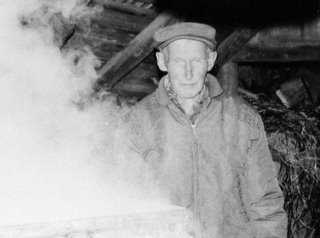

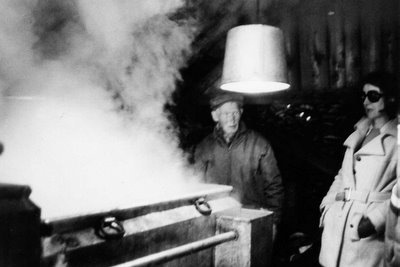

Willie Smail was our next neighbour to the south along Highway 16. He had a maple sugar bush across the highway from us with the sugar shack near the sharp corner in the highway.
The pictures show him boiling the sap to make syrup. To accomplish that, he needed a very hot fire in the evaporator, since the ratio of sap to syrup is 40 to 1. As my father did, Willie used a thermometer to decide when the syrup was ready to be drawn off, filtered through a special felt filter and bottled or canned.
We visited his place in March 1977 on our way to Ottawa. It must have been March Break, because Scott and Shelley are looking at the horses and Paul is just running around. Of course, that is Judy in the sugar shanty with Willie.
The horses were important to pull the sled with the tank on it to gather the sap from the trees. The snow was very deep in the woods, and the tracks between the trees were rough and deeply rutted. To gather the sap from the trees required a hardy soul to plunge through the snow to every tree, empty the buckets into a large pail and then return to the tank to dump it in. It was icy cold, wet work.
Although the job of running the evaporator was the nicest one in many ways, it seemed never ending. When the sap was running, it was difficult to keep up with it, and Willie would boil long into the night.
This kind of operation ended in Groveton when our father and Willie Smail retired.
Saturday, February 04, 2006
Wednesday, February 01, 2006
Paul
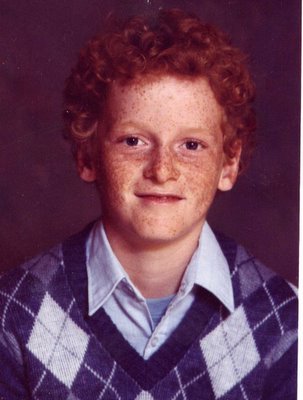
Paul came along much later. We had all been to Kenya for five years from 1966 to 1971 when, on our return, he appeared in Oakville on November 21.
With his distinctive red curly hair, he was a great hit in the supermarkets. The ladies couldn’t stop themselves from touching it.
Possibly in self defence, he always liked to wear hats. He had a great big basket full of hats, and any trip to the market sent him to pick out a hat.
Christenings
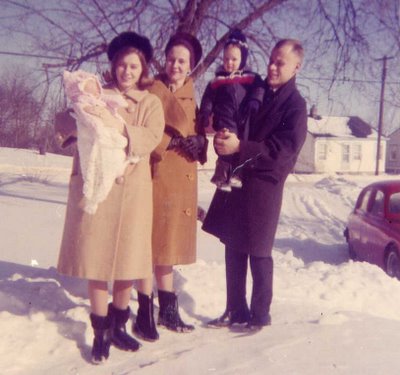

Scott was born on May 1, 1963 and we had him christened in Ottawa with John Bruhwiler as god father and Shelly as god mother holding the subject of the exercise. Shirley and Ray were there. Judy’s mother is on Judy’s right with Sallee Bruhwiler on her left.
Shelley was born on November 28, 1964 in Peterborough. The colour picture shows us at the house in Norwood after her christening. With Judy in the photo are Shelley’s god parents, Frank and Donna Grebenc.
Tuesday, January 31, 2006
Clare and Judy: The Wedding

There are no wedding pictures, so this one will have to do.
We were married quietly in Ottawa in 1962, and we didn’t tell anyone for some time. Judy was working for Trade and Commerce and I was teaching in Madoc. Since she was living with her mother and sister Shelly in Ottawa, we decided to live separately for a while and meet up on weekends.
When we decided that enough was enough, the "coming out" proved interesting. I remember the first time we told anyone in Madoc was at a school dance. "Les", I said to the principal, "this is my wife." His jaw dropped. The look on his face was worth waiting for.
"Meeting up" was sometimes a problem. Judy had a car that she bought for $50 –in those days that was possible– that she used to come up to Madoc on Friday evening and back on Sunday. It was an Austin A40 Devon that had seen better days. It was unsuited to Canadian winters so that the windshield wipers would freeze up and she would have to stop and clear them of ice.
I recall using it in the summer to go camping from Ottawa up into the Gatineau Hills. This model had a trunk lid that opened down so you could pile a lot of stuff on it. We tied all the camping gear on and four or five of us piled into the car, which was now so back heavy that the front wheels almost lifted off the ground. I drove very carefully with the front of the car bouncing up and down.
When she moved to Madoc, Judy sold that car to one of my students for what she paid for it –an exemplary instance of recycling.
Madoc was an interesting experience for Judy. I was in my third year there when she joined me in the little apartment over Devolin’s Grocery store. When she walked down the street past Richard’s Restaurant with her long pony tail and a black turtle neck, the conversation inside was about "that beatnik Judy Henderson." I guess the pair of us seemed a little exotic in those early 60's.
In the summer of 1963, I left my job in Madoc and we moved to Ottawa where Judy returned to work and I returned to school. At Ottawa U, I studied for an MA in English, but I never actually finished it, lacking a thesis, although I knew just about everything there was to know about Harold Pinter and the Theatre of the Absurd by the time we left Ottawa for Norwood.
We stayed in Norwood for two years, but the yearning to travel out of rural Ontario became intense. I applied to teach for the armed forces in Germany and, at the same time, applied to CIDA to teach abroad. In 1966, with two little kids, Scott and Shelley, we flew off to Kenya.
And Kenya is another tale.
George
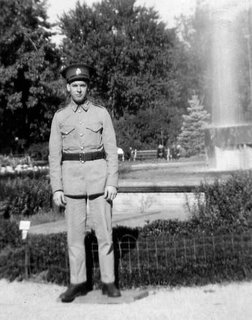


During the second World War, George served from 1940-46 in the Royal Canadian Ordnance Corps ending up as a Regimental Sergeant Major, W.O. 1. When the war was over, he and Captain James L. Cooke went across Canada selling surplus army vehicles. Many a prairie farmer bought a used Jeep or army truck to help on the farm.
From 1946-48, he worked for Barrington Rubber and Plastics, Company in Oakville, but joined James Cooke in 1949 at James L. Cooke Motors, Ltd. in Toronto. When the company bought Toledo Motors in Montreal, George moved in as Manager of Cooke-Toledo Motors and became sole owner in 1960. He sold the business and retired to the farm in the Eastern Townships of Quebec near Brome.
While in Montreal, George sold English cars for Jaguar and Leyland Motors. Jim and Madeline bought a Morris Minor convertible from him and Cooke-Toledo was the source of the red MGA that I drove until my family outgrew it –that is, until there were more than two of us.
Monday, January 30, 2006
40th Wedding Anniversary
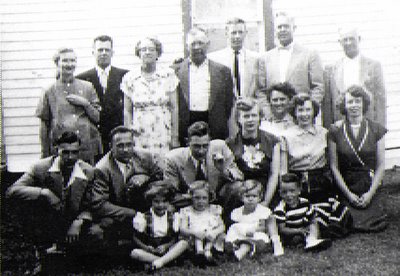
The family came together for our parents’ 40th wedding anniversary and this picture was taken in the back yard of the house.
The Back row has Barbara (pregnant with Liz, born August 31, 1953), Ray, Mother, Father, Clare, George, Uncle Joe.
The Middle row has Mac Simpson on the left, Ivan MacRae, Jim Knox, Dorothy, Shirley, Enid and Madeline.
In front are Joan Simpson, Mary Lyn Henderson, Linda Henderson and Jack Henderson.
The Wedding of George and Barbara
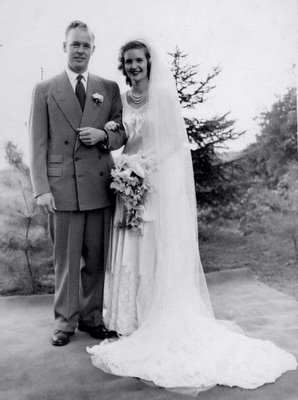
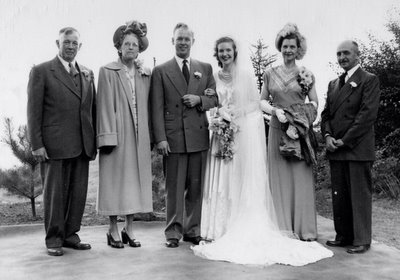

George and Barbara were married in Oakville on September 17, 1949. In attendance were George’s mother and father, William and Margaret Henderson, as well as Barbara’s parents, Ivan and Jessica Spencer.
George’s best man was James L. Cooke, his business partner in Cooke Toledo Motors. Other members of the wedding party include Jim Perry standing second from the left and Joan McCullogh, Maid of Honour, then Dorothia Henderson and John Bancroft, husband of Mary, Barbara’s sister on the right.
Friday, January 27, 2006
The Garden of Groveton
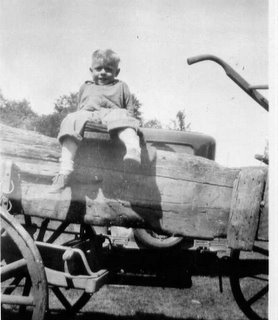
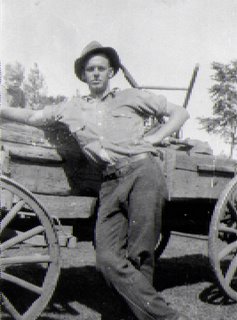
One of the greatest advantages of living on farm during the Great Depressions of the 1930's was that we had lots of food –very little money, but lots of food. Ironically, it was all organically grown and free range. The cows and chickens got lots of fresh air and exercise.
Today organic vegetables are regarded as premium food and free range chicken costs more. Okay, so it’s better and better for you, but you pay. We didn’t even imagine a day when chickens would be like laying machines caged so they cannot move and that vegetables would be grown in hot houses in California to be flown to our urban supermarkets.
You have heard the expression, "Eat Local." None of those New Zealand apples for us. We ate the ones from our own trees. Although we did occasionally eat a few from Willie Smail’s orchard just down the road. The Smails used to watch their orchard very closely, but they lived quite a way from it, so Dorothy used to get me to go with her to secure some of their Macs. We would creep through the woods and slip into the orchard from the rear, pick a few ripe ones and exit the same way. Although they were excellent apples, we didn’t really need them and we know Mother would frown if we told her what we had done. It was the fun of it that counted, and the thrill. Thrills were not easy to come by in the Garden of Groveton.
In our garden we grew great, huge red tomatoes, cucumbers, radishes and onions that we would eat raw and in great quantities all summer long. The potatoes, cabbage, carrots, parsnips and turnips could be stored for winter eating in our cellar. I remember dumping wagon loads of potatoes down a chute into a huge bin in the cellar and then going down into that cold, dark place in December to pick out a pot full for Mother.
The chickens were kept in the chicken coop. Where else? They would range out into the yard to pick and peck, but at dusk they ducked back through the hen door and reserved a spot on a roost for the night. The roosters mingled with the hens. When Mother wanted one for Sunday dinner, I would be dispatched with a sturdy coat hanger opened out with the end bent into a hook. The trick was to pick out a nice plump rooster and snag him by one foot with the hook. There would be lots of wings flapping and hens running and dust rising, but that rooster must die!
We had a block of wood resting on its end behind the house with an axe leaning against it. There was no point in being squeamish when chicken pot pie was promised. Off with its head and into the scalding water to pluck the feathers. Premium quality fresh free range chicken for supper –we called the meal at night supper– with organically grown potatoes and carrots on the side.
We ate okay, Depression or no Depression.
Monday, January 16, 2006
Buckwheat

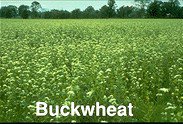

We called it Buckwheat Row, but when they finally put up official signs during the 911 startup, they called it Buckwheat Road. "Road" is likely the proper designation, but it is not much of a road, a narrow, muddy, gravel, potholed track joining the highway at Groveton to the path that leads into the Huckleberry Marsh only two miles away.
The question is how did it get its name? Why "buckwheat"?
The area is called the Groveton Bog, which suggests rather low, wet land imperfect for farming. Indeed it is stony and light where it is not muddy and wet. It is poor land that the Scots who came here in the 1800's looked on favourably. How did the pioneers know? It was covered by forest when they first saw it.
Buckwheat grows just about anywhere, so it would flourish around the Groveton area. It came originally from Asia, then to Europe and at last to Canada. It is an edible grain, both for human and animal, and it has other purposes.
The whole grain can be fed to hens, and it can be cracked to be mixed with other grain for a balanced poultry food.
Buckwheat has a nutty flavour when cooked, kasha being the dried and toasted buckwheat groats. Kasha is used in midEastern dishes, very delicious and easy to make. Even as I write this, Judy is preparing kasha for supper.
Buckwheat is also milled to make the flour especially used to make pancakes and crepes because of the texture and taste, in particular, Galettes de Sarrasin which are basic French crepes made with buckwheat flour. One time we were in France, we stayed overnight in a small city on the Loire and, after finding a hotel room near the river, we strolled around to find a restaurant. We sat down on the patio of La Galette, a restaurant specializing in crepes but featuring Galettes de Sarrasin. They were delicious. You can Google the name for a recipe.
Do we need other purposes for buckwheat? They exist. The buckwheat flower is large and much favoured by bees, so that buckwheat honey can be seen on store shelves. It is dark with a strong taste.
Growing buckwheat has another unusual use that I recall from those farming days long ago. It grows very quickly and is very thick and green. It beats weeds! After growing a crop of oats on a field, sometimes a crop of buckwheat was grown to kill off the weeds, and then at fall plowing time the thick green plants were ploughed under to provide humus to the soil making it richer for a planting the next year. It was similar to letting the land lie fallow but with a super bonus. It was a natural, organic way of getting rid of the weeds and enriching the light soil.
So, why not call it Buckwheat Row?
Saturday, January 14, 2006
Swimming

Growing up at a time in a place when and where there were no community swimming pools, no rivers, no lakes, no real ponds and poor transportation choices meant that learning to swim was virtually impossible.
My firends and I used to search for ponds that were more than knee deep and tried to splash around to get a decent dog paddle going. There was a gravel pit back the highway a few miles that we used to bicycle to, but it was only full of water in the spring when it was too cold to swim.
The Nation River flows through Spencerville, so there was a chance to get into deep water behind the dam, but only if you could already swim. The mighty St. Lawrence is only fifteen miles away, but it might as well have been fifteen hundred.
So now we own a cottage where we spend the summer months fifty feet from the water, a great place for me to cool off on those hot, muggy August days, while others wear out the water with energy and skill. I never found a pond this deep.
Church
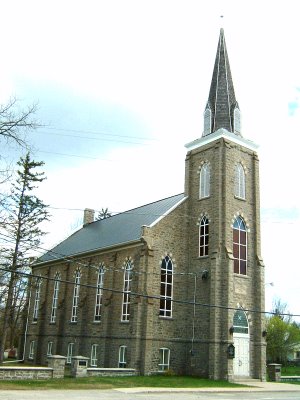
Solid stone. Slate roof from Scotland. Should last forever.
St. Andrews Presbyterian in Spencerville stands proudly on the main street ready to take on all comers.
The church has served many purposes over the years: weddings, christenings, burials. The cemetery behind it is where the Hendersons from Groveton are buried.
In my days of going to church, it was the social gathering for many of my family. It is where I saw my uncles and aunts and cousins on a regular basis.
Everyone would come to church early so they could chat with friends and relatives alike, standing in small groups around the front. They would troupe inside when the bells called them and sit in their own pews. There were no formally reserved pews in the church, but everyone always sat in the same one.
When the Methodists and the Presbyterians joined to start a new church called the United Church, many people left, but, ironically, many people stayed within the Presbyterian Church, and so it continued to exist.
I recall only a small congregation of mostly grey haired seniors, with very few children my own age. When I went to high school and met more of the young people ho lived in the area, I decided that all the good looking girls went to the United Church. That was a revelation.
Mother loved to go to church. She would find me where I was hiding and get me dressed. We were without a car at some times and Mr. Gray would pick us up in his Model T much to my delight.
My father went most of the time, but occasionally we would abstain for some reason. He was a very social person and he loved to talk, so I am sure he loved that aspect of church.
Cemetery in Spencerville
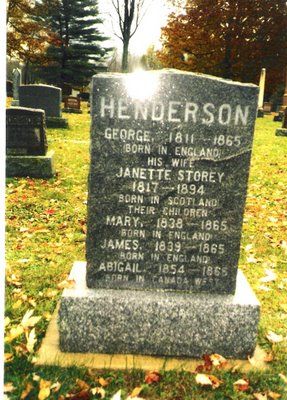
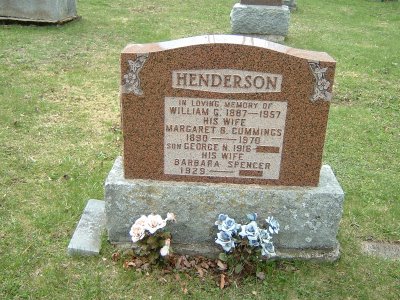
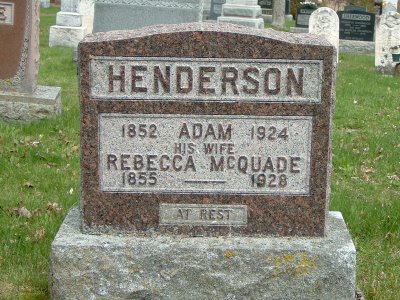
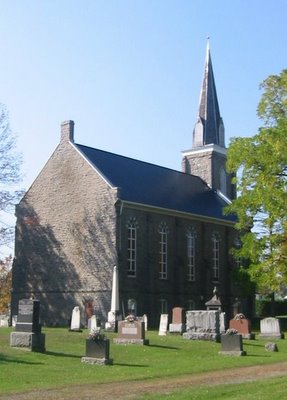
The Cemetery behind St. Andrews Presbyterian Church in Spencerville is the Canadian resting place of the Groveton Henderson lineage, starting with Thomas George Henderson and his wife, Janette (born Storey).
A picture of the gravestone of our grandfather, Adam Henderson and his wife Rebecca (born McQuade) is shown here not far from the gravestone of our father William Grover Henderson and our mother Margaret Blanche (born) Cummings.
The line of the Groveton Hendersons for three generations is buried close together in the same cemetery behind the church that they all attended.
Thursday, January 12, 2006
Eatons Catalogue


The famous Eatons catalogue started with this cover in 1884 and contained most of the essentials for Canadian life, including the "ice refrigerators" in the picture, better known as ice boxes to us.
Living in the country made shopping difficult, so that even furniture and pianos could be ordered and they would deliver it to the door. I still have six press back chairs, rescued from the farm when Mother moved out, that most likely came from Eatons when they were setting up house.
But the Eatons catalogue had other uses. It was a toy. I remember that, when I was a very young boy visiting a certain aunt Belle with my mother, I was given the catalogue and told to amuse myself. Hers was a household where little boys were not heard and were seen as little of as possible.
But I think the most contact I had with the pages of the catalogue was in the outdoor toilet. When the new catalogue arrived, the old one was recycled by being relegated to the toilet in the absence of the kind of gentle, soft tissue we have these days.
Oh, we had it hard in those days. It’s a wonder we survived!
Music
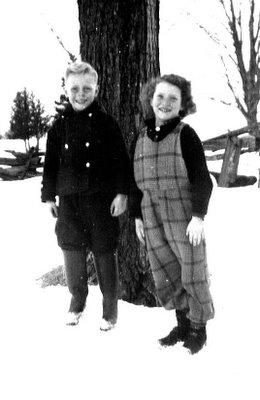
Before electricity, there was music. Apart from the radio, though, it had to be live.
We had a piano in the living room, a black upright with ivory keys purchased, no doubt, from the Eatons catalogue. I remember that Madeline played it by ear, which means that she could rattle off any piece that she had heard.
After she left home to work in Brockville, she brought home a boy friend who was a trained pianist, the first to enter our doorway I am sure. He played Rachmaninoff flawlessly, and I remember sitting enthralled since I had not heard anything in the way of classical music, except on the radio as the introduction to Maw Perkins or another of the afternoon soap operas.
My mother played the piano, but she focussed on hymns. I think she could read music enough to turn out a reasonable rendition of Rock of Ages. In case you don’t know it, this hymn was a favourite at the Presbyterian church service because it is slow and dolorous, suiting the dour gray-haired Scots that attended.
Ray was really musical. He was always picking at a guitar and singing cowboy ballads or squeezing the accordion and belting out the latest songs. He was self-taught, but a natural performer in those days before CDs and iPods.
We had a neighbour that could play the fife and step dance at the same time. Getting Ray and him together for a concert in the living room was really something.
And I used to sing, with the emphasis on "used to." I remember singing "You Are My Sunshine" as a duet with Barbara Douglas at about the age we are in the picture above. That school concert was my debut, and I am sure my sisters thought that it was very cute.
Henderson Family Tree
1 Thomas George HENDERSON
________________________________________
Birth: 1814, England
Death: 20 Mar 1865, Ontario
Burial: Presbyterian Cemetery, Spencerville
Occ: farmer
Reli: Presbyterian
Known as George Henderson on his gravestone. In 1850, the Hendersons came to Canada from Scotland in 1845. Settled on Buckwheat Row. The Dunlop family came with them.
Spouse: Janette STOREY
Birth: Eccles, Berwick, Scotland
Death: 1896, Ventnor
Marr: 24 Dec 1836, Scotland
Children: Adam (1852_1924)
James (1839_1865)
Mary (1838_)
Robert (1843_)
Jane (1844_1922)
Isobel (1847_)
John (1849_)
Abigail (1854_)
George (1858_)
William (1861_)
1.1a Adam HENDERSON*
________________________________________
Birth: 29 Feb 1852, Canada
Death: 1924
Burial: Presbyterian, Spencerville
Occ: Farmer, postmaster in 1897_10_22 until closed in 1913_08_25 (16 years)
When his first wife, Throop, died before he was 21 years of age, Adam married Rebecca McQuade, sister of Albert McQuade. He was separated from his wife, who moved to Moose Jaw, .Saskatoon. Adam became very ill and Margaret nursed him until he died.
He bought the farm from Minor Baker, Yeoman on December 24, 1904 for $600. In, 1925, he sold the farm to William for $2000, and held the mortgage for $1000. When he died, he left all his belongings to William.
His will was probated on February 24, 1925. In it Adam wrote, "I will and direct that all my just debts, funeral and other testamentary expenses be first paid by my executor hereinafter named, as soon after my decease as coinveniently may be.
"All the rest and residue of my estate real, personal, and of every nature and kind of which I die possessed, I will, devise and bequeath to my son William. G. Henderson."
Spouse: Rebecca McQUADE
Birth: 1855, Groveton
Death: 1928, Moosejaw, Saskatchewan
Children: William Grover (1887_1957)
Joseph Byron (1881_)
Newton (1896_1916)
Wilfred (1897_1923)
Eliza
Abigail (1882_)
George (1878_1906)
Other Spouses THROOP, None
1.1a.1 William Grover HENDERSON
________________________________________
Birth: 15 Sep 1887
Death: Jul 1957
Occ: Farmer, ran maple syrup business
Educ: Elementary School
Reli: Presbyterian
The Edwardsburg Township History (page 283_4) notes that many romances sprang up from meetings of The Union Literary Club at the Island School S.S. #16 on Dukelow Road (an extension of Ventnor Road, see map in book). It is here noted that "William Henderson married Margaret Cummings." The Cummings home was on Ventnor Road and Henderson home at Groveton directly on Highway 16.
In 1919, William's father, Adam, owned all of the farm and sold it to William for $2000, taking back a mortgage of $1000. The other $1000 motgage was held by John Jennings, who lived on the concession north pof Groveton. According to William's son, George, "He was a Jewish gentleman, I think. I can remember him pestering my father regularly. He ran a shoe maker's sho[ in Spencerville and drove a horse and buggy every day going right past our house. How convenient to stop in and say hello. 'Oh, by the way, Bill...'" The record of payments from 1920 on tell how hard it was to make money on the farm. The final payment of $300 was made on May 27, 1947.
The family was all born in the house at Groveton corners, and William lived there until his removal to Brockville hospital shortly before his death. Margaret sold the farm eventually and moved to Ottawa for some time and later to Kemptville where she lived in the house owned by her daughter Madeline and husband Jim Knox.
Spouse: Margaret Blanche CUMMINGS
Birth: Nov 1890, Ventnor
Death: 5 Sep 1970, Kemptville
Father: George CUMMINGS (_1923)
Mother: Eleanor GRAY (_1911)
Marr: 25 Jun 1912, Ventnor
Children: Clare (1934_)
Ray (1914_1996)
George Newton (1916_)
Dorothy Isabel (1919_)
Madeline (1928_)
Enid (1926_)
1.1a.1.1 Clare HENDERSON
________________________________________
Birth: 3 Mar 1934, Groveton
Occ: Teacher
Educ: Carleton University
The house on the farm was originally bought by Adam Henderson and sold to William Henderson. All of William and Margaret's six children were born and lived here until they left home.
Spouse: Judith MURDOCK
Birth: 8 Jul 1938, Ottawa
Father: Paul Sackett (Mike) MURDOCK (1916_1966)
Mother: Audrey Gwendolyn SAWYER (1915_1982)
Marr: 10 Aug 1962, Ottawa
Children: Scott (1963_)
Shelley (1964_)
Paul (1971_)
1.1a.1.1.1 Scott HENDERSON
________________________________________
Birth: 1 May 1963, Belleville
Occ: Theatrical Lighting Designer
Educ: Ryerson University
Spouse: Karen TOLE
Birth: 1965, Pilot Mound
Father: Kenneth TOLE
Mother: Anne
Marr: 10 Aug 1987, Kahshe Lake
Children: Sean (1998_)
Alexander (2000_)
1.1a.1.1.2 Shelley HENDERSON
________________________________________
Birth: 28 Nov 1964, Peterborough
Occ: Teacher of German and French
Educ: Brock University and Albert Ludwig University, Freiburg, Germany
Spouse: Mark WHALE
Birth: England
Father: Jeffrey WHALE
Mother: Margaret
Children: Rachael (1989_)
Sophie (1991_)
1.1a.1.1.3 Paul HENDERSON
________________________________________
Birth: 21 Nov 1971, Oakville
Occ: Silviculturist; Journalist
Educ: University of Western Ontario and Langara College
1.1a.1.2 Ray HENDERSON
________________________________________
Birth: 5 Aug 1914, Spencerville, Ontario
Death: 19 Feb 1996, Victoria, B.C.
Occ: Teacher/Pilot
Educ: Kemptville Agricultural College, Ottawa Normal School, Queens University
Served in the air force as a bomber pilot during WW2. Reenlisted and served for 25 years. Wing Commander.
Memorial Service February 24, 1996 at St. George's Church, Cadboro Bay, Victoria, B.C.
Spouse: Shirley Mae PRETTE
Children: Mary Lyn
Jack
Margaret Rose
Anne Marie
Julie Anne
1.1a.1.2.1 Mary Lyn HENDERSON
________________________________________
Spouse: Bob HANNAH
Children: David
1.1a.1.2.2 Jack HENDERSON
________________________________________
1.1a.1.2.3 Margaret Rose HENDERSON
________________________________________
Spouse: James BARTLETT
Marr: 24 Mar 2002
1.1a.1.2.4 Anne Marie HENDERSON
________________________________________
Spouse: Steven WALKER
Children: Ryan
1.1a.1.2.5 Julie Anne HENDERSON
________________________________________
Spouse: Lawrie SPOONER
Children: Miles
Angela
1.1a.1.3 George Newton HENDERSON
________________________________________
Birth: 23 Aug 1916
Occ: Businessman
Educ: Spencerville Continuation School
Served in the army during WW2
Spouse: Barbara Ann SPENCER
Children: Linda (1950_)
Judy (1961_)
Elizabeth (1953_)
Edward (Ted)
1.1a.1.3.1 Linda HENDERSON
________________________________________
Birth: 23 Nov 1950, Oakville, Ontario
Occ: Campground Manager
Educ: Junior Matric
Reli: Universalist
Spouse: David LAKE
Birth: 1 Jun 1954, Nelson, B.C.
Father: Quentin LAKE
Mother: Jean HORNER
Marr: 12 Dec 1973, Vernon, B.C.
Children: Chelsea (1984_)
Rebecca (1990_)
1.1a.1.3.2 Judy HENDERSON
________________________________________
Birth: 3 Feb 1961, Montreal General Hospital
Occ: Account Executive
Educ: Dorval High School; Humber College
Reli: Protestant
Spouse: Marty LAVOIE
Birth: 5 Apr 1969, Montreal General
Father: Andre Jacques LAVOIE
Mother: Gisele THIFAULT
Children: Leah Rene (1997_)
Riley Andrew (2000_)
1.1a.1.3.3 Elizabeth HENDERSON
________________________________________
Birth: 31 Aug 1953, Toronto
Occ: Naturotherapist/Bookkeeper
Educ: Sudbury School of Esthetics, Medical Office Assistant, French Finishing School (Switzerland), Commercial (Dorval)
Reli: New
Fluently Bilingual (French_English)
Golf, Skiing
Part time Naturotherapist
Spouse: Gerry BROWN
Div: Ottawa
Children: Laura (1983_)
Phil (1987_)
1.1a.1.3.4 Edward (Ted) HENDERSON
________________________________________
1.1a.1.4 Dorothy Isabel HENDERSON
________________________________________
Birth: 16 Aug 1919, Groveton
Occ: Nurse in Montreal
Educ: Registered Nurse, Brockville General Hospital, graduated 1940
Reli: Presbyterian
After marriage to Ivan, lived in Verdun, P.Q. until move to Waterdown and later Burlington after retirement. Sold Waterdown house to son, David.
Dorothy is named Isabel after Aunt Isobel Cummings
Left home at 18 to train as a nurse at Brockville Hospital. Became an R.N.
Spouse: Ivan MACRAE
Birth: 4 Mar 1923, Blackville, N.B.
Marr: 8 Mar 1948, St. John the Divine, Verdun
Children: Carol Ann (1958_)
David Ian Andrew (1962_)
1.1a.1.4.1 Carol Ann MACRAE
________________________________________
Birth: 5 Nov 1958, Montreal General Hospital
Occ: Accountant
Educ: McMaster, Honours Student
Reli: Church of England
Spouse: Larry HUZAK
Birth: 25 Mar 1954
Marr: 26 Dec 1983
Children: Jennifer Lauren (1991_)
Alison (1994_)
1.1a.1.4.2 David Ian Andrew MACRAE
________________________________________
Birth: 14 Oct 1962, Montreal General Hospital
Occ: Businessman
Educ: McMaster U; Sheridan College
Reli: Church of England
Spouse: Janette Mendida BARBACHANO
Birth: 17 Dec 1964
Father: Jose BARBACHANO
Mother: Menda
Children: Hailey Isabel (1996_)
Ryan (1998_)
1.1a.1.5 Madeline HENDERSON
________________________________________
Birth: 1928
Occ: Housewife
Spouse: James KNOX
Birth: 17 May 1922
Death: 10 Jan 2000
Children: Doug (_2002)
Barrie
Rickie
Michael
1.1a.1.5.1 Doug KNOX
________________________________________
Death: 15 Oct 2002
Burial: 26 Oct 2002, Knox Presbyterian Cemetery, Spencerville
Spouse: Joanne
1.1a.1.5.2 Barrie KNOX
________________________________________
Occ: Pharmaceutical company in Oakville
1.1a.1.5.3 Rickie KNOX
________________________________________
Occ: Air Force, helicopter mechanic
1.1a.1.5.4 Michael KNOX
________________________________________
Occ: Police Detective with OPP
Educ: Carleton University
1.1a.1.6 Enid HENDERSON
________________________________________
Birth: 1926
Occ: Housewife
Spouse: Malcolm SIMPSON
Children: Joan
1.1a.1.6.1 Joan SIMPSON
________________________________________
Spouse: Bruce
1.1a.2 Joseph Byron HENDERSON
________________________________________
Birth: 7 Jun 1881, Groveton
Went to Syracuse at 17. Lived in Miami, Florida in the winter.
Spouse: Daisy
Marr: Utica, New York, USA
1.1a.3 Newton HENDERSON
________________________________________
Birth: 31 Aug 1896
Death: 1916
Occ: farmer
Reli: Methodist
Killed during WW1 at 19 years. Regimental Number 639624 (National Archives: RG150, Acc. 1992_93/166 Box 4257_33.
Signed attestation papers on February 1, 1916. He was fair with blue eyes and red hair. (Refer to the National Archives on_line database.)
1.1a.4 Wilfred HENDERSON
________________________________________
Birth: 1897
Death: 1923, Died of TB at age 27
Died of TB at a young age.
Spouse: Sarah PERRY
1.1a.5 Eliza HENDERSON
________________________________________
Spouse: Howard KINGSTON
1.1a.6 Abigail HENDERSON
________________________________________
Birth: 1882, Groveton
Lived in Finch, Oshawa, and Dault St. Marie
Spouse: MACKEY/MACKIE
Children: Edgar
Ralph
Viola
1.1a.6.1 Edgar MACKEY
________________________________________
1.1a.6.2 Ralph MACKEY
________________________________________
1.1a.6.3 Viola MACKEY
________________________________________
1.1a.7 George HENDERSON
________________________________________
Birth: 1878, Groveton
Death: 1906, Died of TB at age 28
Burial: Wisconsin
1.1b Adam HENDERSON* (See above)
________________________________________
Spouse: THROOP
Children: Sheldon
Other Spouses Rebecca McQUADE
1.1b.1 Sheldon HENDERSON
________________________________________
1.1c Adam HENDERSON* (See above)
________________________________________
Children: Sheldon
Other Spouses Rebecca McQUADE, THROOP
1.1c.1 Sheldon HENDERSON
________________________________________
1.2 James HENDERSON
________________________________________
Birth: 26 Sep 1839, Scotland
Death: 23 Jun 1865, Canada
1.3 Mary HENDERSON
________________________________________
Birth: 1838, Scotland
1.4 Robert HENDERSON
________________________________________
Birth: 16 Jan 1843, Scotland
Spouse: Jane CLIFFORD
Children: George
Minor
1.4.1 George HENDERSON
________________________________________
George and Lois went west and when Lois died, their father sent the children home and the Lemmon sisters raised them. George remarried and died leaving another family.
Spouse: Lois LEMMON
Children: Jessie
Hattie
Ralph
Annie
Minnie
1.4.1.1 Jessie HENDERSON
________________________________________
1.4.1.2 Hattie HENDERSON
________________________________________
1.4.1.3 Ralph HENDERSON
________________________________________
1.4.1.4 Annie HENDERSON
________________________________________
1.4.1.5 Minnie HENDERSON
________________________________________
1.4.2 Minor HENDERSON
________________________________________
1.5 Jane HENDERSON
________________________________________
Birth: 10 Jul 1844, Scotland
Death: 20 Aug 1922
1.6 Isobel HENDERSON
________________________________________
Birth: 1847, Scotland
1.7a John HENDERSON*
________________________________________
Birth: 1849, Scotland
Occ: farmer
Moved to the north side of the 8th concession near Ventnor before his mother bought the other Henderson farm across the road.
The children of John not mentioned here moved to the USA anmd settled around Springfield and Elkhorn, Wisconsin.
Spouse: McGerry
Children: Mary Jane (1872_)
Sarah Abigail
James Henry
Other Spouses Jane Irving
1.7a.1 Mary Jane HENDERSON
________________________________________
Birth: 1872
1.7a.2 Sarah Abigail HENDERSON
________________________________________
Spouse: Sam LAMPSON
1.7a.3 James Henry HENDERSON
________________________________________
1.7b John HENDERSON* (See above)
________________________________________
Spouse: Jane Irving
Children: Perley
Robert
Maud
Annie
Bessie
Other Spouses McGerry
1.7b.1 Perley HENDERSON
________________________________________
1.7b.2 Robert HENDERSON
________________________________________
1.7b.3 Maud HENDERSON
________________________________________
Spouse: William KEYES
1.7b.4 Annie HENDERSON
________________________________________
1.7b.5 Bessie HENDERSON
________________________________________
1.8 Abigail HENDERSON
________________________________________
Birth: 1854, Canada
1.9 George HENDERSON
________________________________________
Birth: 1858, Canada
1.10 William HENDERSON
________________________________________
Birth: 1861, Canada
________________________________________
Birth: 1814, England
Death: 20 Mar 1865, Ontario
Burial: Presbyterian Cemetery, Spencerville
Occ: farmer
Reli: Presbyterian
Known as George Henderson on his gravestone. In 1850, the Hendersons came to Canada from Scotland in 1845. Settled on Buckwheat Row. The Dunlop family came with them.
Spouse: Janette STOREY
Birth: Eccles, Berwick, Scotland
Death: 1896, Ventnor
Marr: 24 Dec 1836, Scotland
Children: Adam (1852_1924)
James (1839_1865)
Mary (1838_)
Robert (1843_)
Jane (1844_1922)
Isobel (1847_)
John (1849_)
Abigail (1854_)
George (1858_)
William (1861_)
1.1a Adam HENDERSON*
________________________________________
Birth: 29 Feb 1852, Canada
Death: 1924
Burial: Presbyterian, Spencerville
Occ: Farmer, postmaster in 1897_10_22 until closed in 1913_08_25 (16 years)
When his first wife, Throop, died before he was 21 years of age, Adam married Rebecca McQuade, sister of Albert McQuade. He was separated from his wife, who moved to Moose Jaw, .Saskatoon. Adam became very ill and Margaret nursed him until he died.
He bought the farm from Minor Baker, Yeoman on December 24, 1904 for $600. In, 1925, he sold the farm to William for $2000, and held the mortgage for $1000. When he died, he left all his belongings to William.
His will was probated on February 24, 1925. In it Adam wrote, "I will and direct that all my just debts, funeral and other testamentary expenses be first paid by my executor hereinafter named, as soon after my decease as coinveniently may be.
"All the rest and residue of my estate real, personal, and of every nature and kind of which I die possessed, I will, devise and bequeath to my son William. G. Henderson."
Spouse: Rebecca McQUADE
Birth: 1855, Groveton
Death: 1928, Moosejaw, Saskatchewan
Children: William Grover (1887_1957)
Joseph Byron (1881_)
Newton (1896_1916)
Wilfred (1897_1923)
Eliza
Abigail (1882_)
George (1878_1906)
Other Spouses THROOP, None
1.1a.1 William Grover HENDERSON
________________________________________
Birth: 15 Sep 1887
Death: Jul 1957
Occ: Farmer, ran maple syrup business
Educ: Elementary School
Reli: Presbyterian
The Edwardsburg Township History (page 283_4) notes that many romances sprang up from meetings of The Union Literary Club at the Island School S.S. #16 on Dukelow Road (an extension of Ventnor Road, see map in book). It is here noted that "William Henderson married Margaret Cummings." The Cummings home was on Ventnor Road and Henderson home at Groveton directly on Highway 16.
In 1919, William's father, Adam, owned all of the farm and sold it to William for $2000, taking back a mortgage of $1000. The other $1000 motgage was held by John Jennings, who lived on the concession north pof Groveton. According to William's son, George, "He was a Jewish gentleman, I think. I can remember him pestering my father regularly. He ran a shoe maker's sho[ in Spencerville and drove a horse and buggy every day going right past our house. How convenient to stop in and say hello. 'Oh, by the way, Bill...'" The record of payments from 1920 on tell how hard it was to make money on the farm. The final payment of $300 was made on May 27, 1947.
The family was all born in the house at Groveton corners, and William lived there until his removal to Brockville hospital shortly before his death. Margaret sold the farm eventually and moved to Ottawa for some time and later to Kemptville where she lived in the house owned by her daughter Madeline and husband Jim Knox.
Spouse: Margaret Blanche CUMMINGS
Birth: Nov 1890, Ventnor
Death: 5 Sep 1970, Kemptville
Father: George CUMMINGS (_1923)
Mother: Eleanor GRAY (_1911)
Marr: 25 Jun 1912, Ventnor
Children: Clare (1934_)
Ray (1914_1996)
George Newton (1916_)
Dorothy Isabel (1919_)
Madeline (1928_)
Enid (1926_)
1.1a.1.1 Clare HENDERSON
________________________________________
Birth: 3 Mar 1934, Groveton
Occ: Teacher
Educ: Carleton University
The house on the farm was originally bought by Adam Henderson and sold to William Henderson. All of William and Margaret's six children were born and lived here until they left home.
Spouse: Judith MURDOCK
Birth: 8 Jul 1938, Ottawa
Father: Paul Sackett (Mike) MURDOCK (1916_1966)
Mother: Audrey Gwendolyn SAWYER (1915_1982)
Marr: 10 Aug 1962, Ottawa
Children: Scott (1963_)
Shelley (1964_)
Paul (1971_)
1.1a.1.1.1 Scott HENDERSON
________________________________________
Birth: 1 May 1963, Belleville
Occ: Theatrical Lighting Designer
Educ: Ryerson University
Spouse: Karen TOLE
Birth: 1965, Pilot Mound
Father: Kenneth TOLE
Mother: Anne
Marr: 10 Aug 1987, Kahshe Lake
Children: Sean (1998_)
Alexander (2000_)
1.1a.1.1.2 Shelley HENDERSON
________________________________________
Birth: 28 Nov 1964, Peterborough
Occ: Teacher of German and French
Educ: Brock University and Albert Ludwig University, Freiburg, Germany
Spouse: Mark WHALE
Birth: England
Father: Jeffrey WHALE
Mother: Margaret
Children: Rachael (1989_)
Sophie (1991_)
1.1a.1.1.3 Paul HENDERSON
________________________________________
Birth: 21 Nov 1971, Oakville
Occ: Silviculturist; Journalist
Educ: University of Western Ontario and Langara College
1.1a.1.2 Ray HENDERSON
________________________________________
Birth: 5 Aug 1914, Spencerville, Ontario
Death: 19 Feb 1996, Victoria, B.C.
Occ: Teacher/Pilot
Educ: Kemptville Agricultural College, Ottawa Normal School, Queens University
Served in the air force as a bomber pilot during WW2. Reenlisted and served for 25 years. Wing Commander.
Memorial Service February 24, 1996 at St. George's Church, Cadboro Bay, Victoria, B.C.
Spouse: Shirley Mae PRETTE
Children: Mary Lyn
Jack
Margaret Rose
Anne Marie
Julie Anne
1.1a.1.2.1 Mary Lyn HENDERSON
________________________________________
Spouse: Bob HANNAH
Children: David
1.1a.1.2.2 Jack HENDERSON
________________________________________
1.1a.1.2.3 Margaret Rose HENDERSON
________________________________________
Spouse: James BARTLETT
Marr: 24 Mar 2002
1.1a.1.2.4 Anne Marie HENDERSON
________________________________________
Spouse: Steven WALKER
Children: Ryan
1.1a.1.2.5 Julie Anne HENDERSON
________________________________________
Spouse: Lawrie SPOONER
Children: Miles
Angela
1.1a.1.3 George Newton HENDERSON
________________________________________
Birth: 23 Aug 1916
Occ: Businessman
Educ: Spencerville Continuation School
Served in the army during WW2
Spouse: Barbara Ann SPENCER
Children: Linda (1950_)
Judy (1961_)
Elizabeth (1953_)
Edward (Ted)
1.1a.1.3.1 Linda HENDERSON
________________________________________
Birth: 23 Nov 1950, Oakville, Ontario
Occ: Campground Manager
Educ: Junior Matric
Reli: Universalist
Spouse: David LAKE
Birth: 1 Jun 1954, Nelson, B.C.
Father: Quentin LAKE
Mother: Jean HORNER
Marr: 12 Dec 1973, Vernon, B.C.
Children: Chelsea (1984_)
Rebecca (1990_)
1.1a.1.3.2 Judy HENDERSON
________________________________________
Birth: 3 Feb 1961, Montreal General Hospital
Occ: Account Executive
Educ: Dorval High School; Humber College
Reli: Protestant
Spouse: Marty LAVOIE
Birth: 5 Apr 1969, Montreal General
Father: Andre Jacques LAVOIE
Mother: Gisele THIFAULT
Children: Leah Rene (1997_)
Riley Andrew (2000_)
1.1a.1.3.3 Elizabeth HENDERSON
________________________________________
Birth: 31 Aug 1953, Toronto
Occ: Naturotherapist/Bookkeeper
Educ: Sudbury School of Esthetics, Medical Office Assistant, French Finishing School (Switzerland), Commercial (Dorval)
Reli: New
Fluently Bilingual (French_English)
Golf, Skiing
Part time Naturotherapist
Spouse: Gerry BROWN
Div: Ottawa
Children: Laura (1983_)
Phil (1987_)
1.1a.1.3.4 Edward (Ted) HENDERSON
________________________________________
1.1a.1.4 Dorothy Isabel HENDERSON
________________________________________
Birth: 16 Aug 1919, Groveton
Occ: Nurse in Montreal
Educ: Registered Nurse, Brockville General Hospital, graduated 1940
Reli: Presbyterian
After marriage to Ivan, lived in Verdun, P.Q. until move to Waterdown and later Burlington after retirement. Sold Waterdown house to son, David.
Dorothy is named Isabel after Aunt Isobel Cummings
Left home at 18 to train as a nurse at Brockville Hospital. Became an R.N.
Spouse: Ivan MACRAE
Birth: 4 Mar 1923, Blackville, N.B.
Marr: 8 Mar 1948, St. John the Divine, Verdun
Children: Carol Ann (1958_)
David Ian Andrew (1962_)
1.1a.1.4.1 Carol Ann MACRAE
________________________________________
Birth: 5 Nov 1958, Montreal General Hospital
Occ: Accountant
Educ: McMaster, Honours Student
Reli: Church of England
Spouse: Larry HUZAK
Birth: 25 Mar 1954
Marr: 26 Dec 1983
Children: Jennifer Lauren (1991_)
Alison (1994_)
1.1a.1.4.2 David Ian Andrew MACRAE
________________________________________
Birth: 14 Oct 1962, Montreal General Hospital
Occ: Businessman
Educ: McMaster U; Sheridan College
Reli: Church of England
Spouse: Janette Mendida BARBACHANO
Birth: 17 Dec 1964
Father: Jose BARBACHANO
Mother: Menda
Children: Hailey Isabel (1996_)
Ryan (1998_)
1.1a.1.5 Madeline HENDERSON
________________________________________
Birth: 1928
Occ: Housewife
Spouse: James KNOX
Birth: 17 May 1922
Death: 10 Jan 2000
Children: Doug (_2002)
Barrie
Rickie
Michael
1.1a.1.5.1 Doug KNOX
________________________________________
Death: 15 Oct 2002
Burial: 26 Oct 2002, Knox Presbyterian Cemetery, Spencerville
Spouse: Joanne
1.1a.1.5.2 Barrie KNOX
________________________________________
Occ: Pharmaceutical company in Oakville
1.1a.1.5.3 Rickie KNOX
________________________________________
Occ: Air Force, helicopter mechanic
1.1a.1.5.4 Michael KNOX
________________________________________
Occ: Police Detective with OPP
Educ: Carleton University
1.1a.1.6 Enid HENDERSON
________________________________________
Birth: 1926
Occ: Housewife
Spouse: Malcolm SIMPSON
Children: Joan
1.1a.1.6.1 Joan SIMPSON
________________________________________
Spouse: Bruce
1.1a.2 Joseph Byron HENDERSON
________________________________________
Birth: 7 Jun 1881, Groveton
Went to Syracuse at 17. Lived in Miami, Florida in the winter.
Spouse: Daisy
Marr: Utica, New York, USA
1.1a.3 Newton HENDERSON
________________________________________
Birth: 31 Aug 1896
Death: 1916
Occ: farmer
Reli: Methodist
Killed during WW1 at 19 years. Regimental Number 639624 (National Archives: RG150, Acc. 1992_93/166 Box 4257_33.
Signed attestation papers on February 1, 1916. He was fair with blue eyes and red hair. (Refer to the National Archives on_line database.)
1.1a.4 Wilfred HENDERSON
________________________________________
Birth: 1897
Death: 1923, Died of TB at age 27
Died of TB at a young age.
Spouse: Sarah PERRY
1.1a.5 Eliza HENDERSON
________________________________________
Spouse: Howard KINGSTON
1.1a.6 Abigail HENDERSON
________________________________________
Birth: 1882, Groveton
Lived in Finch, Oshawa, and Dault St. Marie
Spouse: MACKEY/MACKIE
Children: Edgar
Ralph
Viola
1.1a.6.1 Edgar MACKEY
________________________________________
1.1a.6.2 Ralph MACKEY
________________________________________
1.1a.6.3 Viola MACKEY
________________________________________
1.1a.7 George HENDERSON
________________________________________
Birth: 1878, Groveton
Death: 1906, Died of TB at age 28
Burial: Wisconsin
1.1b Adam HENDERSON* (See above)
________________________________________
Spouse: THROOP
Children: Sheldon
Other Spouses Rebecca McQUADE
1.1b.1 Sheldon HENDERSON
________________________________________
1.1c Adam HENDERSON* (See above)
________________________________________
Children: Sheldon
Other Spouses Rebecca McQUADE, THROOP
1.1c.1 Sheldon HENDERSON
________________________________________
1.2 James HENDERSON
________________________________________
Birth: 26 Sep 1839, Scotland
Death: 23 Jun 1865, Canada
1.3 Mary HENDERSON
________________________________________
Birth: 1838, Scotland
1.4 Robert HENDERSON
________________________________________
Birth: 16 Jan 1843, Scotland
Spouse: Jane CLIFFORD
Children: George
Minor
1.4.1 George HENDERSON
________________________________________
George and Lois went west and when Lois died, their father sent the children home and the Lemmon sisters raised them. George remarried and died leaving another family.
Spouse: Lois LEMMON
Children: Jessie
Hattie
Ralph
Annie
Minnie
1.4.1.1 Jessie HENDERSON
________________________________________
1.4.1.2 Hattie HENDERSON
________________________________________
1.4.1.3 Ralph HENDERSON
________________________________________
1.4.1.4 Annie HENDERSON
________________________________________
1.4.1.5 Minnie HENDERSON
________________________________________
1.4.2 Minor HENDERSON
________________________________________
1.5 Jane HENDERSON
________________________________________
Birth: 10 Jul 1844, Scotland
Death: 20 Aug 1922
1.6 Isobel HENDERSON
________________________________________
Birth: 1847, Scotland
1.7a John HENDERSON*
________________________________________
Birth: 1849, Scotland
Occ: farmer
Moved to the north side of the 8th concession near Ventnor before his mother bought the other Henderson farm across the road.
The children of John not mentioned here moved to the USA anmd settled around Springfield and Elkhorn, Wisconsin.
Spouse: McGerry
Children: Mary Jane (1872_)
Sarah Abigail
James Henry
Other Spouses Jane Irving
1.7a.1 Mary Jane HENDERSON
________________________________________
Birth: 1872
1.7a.2 Sarah Abigail HENDERSON
________________________________________
Spouse: Sam LAMPSON
1.7a.3 James Henry HENDERSON
________________________________________
1.7b John HENDERSON* (See above)
________________________________________
Spouse: Jane Irving
Children: Perley
Robert
Maud
Annie
Bessie
Other Spouses McGerry
1.7b.1 Perley HENDERSON
________________________________________
1.7b.2 Robert HENDERSON
________________________________________
1.7b.3 Maud HENDERSON
________________________________________
Spouse: William KEYES
1.7b.4 Annie HENDERSON
________________________________________
1.7b.5 Bessie HENDERSON
________________________________________
1.8 Abigail HENDERSON
________________________________________
Birth: 1854, Canada
1.9 George HENDERSON
________________________________________
Birth: 1858, Canada
1.10 William HENDERSON
________________________________________
Birth: 1861, Canada
Wednesday, January 04, 2006
The Huckleberry Marsh

Buckwheat Row is only about 2 miles long, running from Groveton on Highway 16 to the Huckleberry Marsh. There is no road through the marsh, so you have to turn around and bounce back to the highway over the potholes in the narrow gravel road that serves a dozen farms.
The senior Mr. Kingston was the harbinger of ripe huckleberries. He would walk into the marsh and when they were ripe in June he would spread the news, which was not as difficult as it would seem since we had a party line that included the whole area. The party line served the function that the Internet serves today –spreading the news!
Huckleberries are different from blueberries, darker in colour and growing on quite high bushes, but tasting a lot like wild blueberries and serving the same function in pies and on the table. We would travel there by horse and wagon, usually as a whole family, carrying milk pails to pick in. It was a long walk from the end of the road out into the marsh requiring rubber boots and lots of energy.
The great thing about picking huckleberries is that they grow on bushes, not near the ground as wild blueberries do, so filling a pail did not take all that long. They grow in bunches as the picture suggests, so they can be collected by the handful. The struggle was to get those huge pails brimful with ripe berries back to the wagon safely.
Needless to say we ate lots of berries while we picked, for huckleberries are juicy and rich. But the huckleberry shortcake and the pie was what we really looked forward to as the reward for picking.
Life in a One-Room Schoolhouse

I started school when I was only 4 going on 5, because my brother Ray was the teacher and he took pity on me. I would stand alone at our house and watch the kids playing and having a great deal of fun in the school yard just across the highway. He finally took me by the hand and led me across the road, my start at formal learning.
The school room was set up with the little desks in a row on one side of the space with each row getting larger and larger until the big desks lined the other side of the room. At the front were two blackboards with risers in front of them. The teacher’s desk was there as well. In the very centre was a large wood-burning stove designed to keep the schoolhouse warm in winter. Sometimes it was so cold in January, that we all had to huddle around the stove to keep from freezing.
The school building was built of stone as you can see in the photograph. It had three large windows on each side and two windows at the door end. The other end had a door leading to the huge wood shed that was piled to the roof with split maple to burn in winter. It made a great place to hide during recess when we played hide and seek. Sometimes we would climb in among the piles of wood and block up the hole so we couldn’t be seen. Unfortunately, we always had to appear when the school bell rang to end recess.
The teacher must have been pretty busy with kids from grades one to eight. As each person grew larger they moved to a larger desk, and, presumably, a higher grade. I imagine the teacher grouped kids as much by ability as by age, which was great advantage for kids with ability. One of the great advantages of a one-room school house is that everybody gets to hear all of the lessons. I remember wondering why those big guys didn’t know the answers to the teacher’s questions when they seemed obvious to me. I mean, there’s the map on the wall. Java is right there –that pink island in the Pacific Ocean!
Those were the days of the grade 8 examinations, the entrance to high school. I recall that Keith Somerville and I were the top students in grade 8 and had no trouble passing the examinations, but not everyone passed them because not everyone continued on to high school.
I remember most of my school mates well. In the photo, that is me at the left in front beside Harold Kingston and Keith Somerville. Behind us are Barbara Douglas, Audrey Grue and Rita Kingston. I cannot identify the rest.
Life in the one-room school house had its advantages. You certainly got to know everyone.
Fishing

Where I grew up, fishing mostly meant fishing for mudpout. Mudpout is the local name for a fish that abounds in Southern Ontario, and is also known as bullhead, catfish, barbotte and mud cat.
And the rule of thumb was, "They only bite when the mosquitoes do!"
The equipment was simple, a pole a line, a hook and a can of worms. Of course, a drive to the river was essential, and it had to be at dusk.
Catfish, or mudpout as we called them, live in slow moving, warm water, the kind you find in the small rivers of Southern Ontario. We used to go to branch of the Nation River and toss in the worm. In between slapping the mosquitoes, we would pull in the lines and fill a bucket with fish. People boasted of the number they caught the night before, and under a hundred was a pointless boast.
Mudpout are easy to clean, which includes skinning them. We used to clean them all and fry up a batch in butter. The fillet comes off the bone easily in one piece, and the next boast was about how many you could eat at one sitting.
Fresh mudpout is hard to beat. They are delicious!Wednesday, December 28, 2005
Strawberry Jam

 There is nothing as sweet as wild strawberries.
There is nothing as sweet as wild strawberries.
I remember going picking strawberries in the warm July sun, sitting on the ground and delicately pinching off those tiny berries and dropping them in a small container –my mouth! I used to eat more than I picked, but still the object was to get enough home to fill a strawberry shortcake made with whipped cream from the farm.
This was all before the days of cultivated strawberries, which I have to admit now can be very good indeed, especially in the middle of February in the form of freezer jam or just thawed berries over yogurt or ice cream. In the days before electricity and freezers, it was preserved jam that carried that great taste over into winter.
We used to buy sugar in 100 pound bags and stand them behind the hall door with the 100 pound bag of flour. A lot of preserving went on in the days before refrigerators, all of it stored on shelves in the cellar just across from the bins of potatoes and cabbages. Throughout summer and fall, my mother would spend hours over a hot fire with the preserving kettle steaming away. The results were spectacular.
But of all of the preserved jams and food, the most delicate and the richest was the wild strawberry jam.Tuesday, December 27, 2005
Voting

When election time comes around now, it makes me recall what people used to say when I was too young to vote. My father (shown here sitting on that '31 Buick) was returning officer for more than one election, the vote taking place in the Groveton school house.
My father was a liberal, as I recall, and I guess my mother was as well. In any case, it was not a topic of much conversation at the table, so they were amicable about it. Not so every couple. "She killed his vote", they would say, when a wife voted opposite to her husband. This was an unpunished crime.
After the votes were counted, people would speculate on who had changed their vote. Everyone knew everyone else so well, that they could count up the votes to see who had switched parties and to check if anyone had killed her husband’s vote.
There is an up side to living in a small, stable community, and a down side, and election day always brought out the interesting side.Sunday, December 25, 2005
Barry's Pancakes

Madeline and Jim had four sons, two of whom appear in the picture. Doug, the eldest, is on the right side of his grandmother, and Barry is on her left.
Barry, who now lives in Oakville, has been reading this memoir/family history and has his own memories of visiting the farm.
He writes: Grandma Henderson made the best pancakes. I held the record among us kids of 14 eaten at one sitting. I'd like to try to break that record, but you can't get pancakes like that anymore.
Her porridge was delicious too. I still eat oatmeal everyday to keep the cholesterol down, but, when I make it, it tastes like wet cardboard. She used to stir in butter and cream and top it with maple syrup, of course.
I remember drizzling hot maple syrup from the evaporator on the snow and then eating it like candy when it hardened.
It seems most of my memories of visiting the Grandparents’ farm involve food.Friday, December 23, 2005
Boarding the Teacher
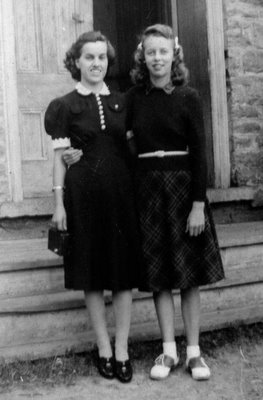
You’ve seen the house where we were all born. It’s small by just about any standards. There were only two rooms on the main floor and only three bedrooms upstairs.
There was, of course, no basement, only a damp cellar with a large cistern for rain water to collect in and the bins for potatoes, carrots, cabbages and other winter food.
I remember picking the potatoes in the fall and dumping them into a wagon box, which was unloaded using a chute that ran from the wagon in through a cellar window to the potato bin. We ate a lot of potatoes!
The cistern was pretty important, since it collected rain water from the roof that we used for washing. It was nice soft water, great for the Saturday night bath, compared to the well water that was so hard it made the soap congeal.
When I grew up, I had a bedroom to myself and we actually had a guest room, but I wondered what happened when all five kids were there –and the teacher, because we boarded the teacher as an income in those hard depression years.
So where did everybody sleep? Well, the teacher had to have a room of her own, so that left two bedrooms. One bedroom was for the boys, of course. There were two double beds in my parents' room, so that took care of two of the girls. That left someone over. Dorothy solved the numbers problem by explaining that she slept at the end of the hall with the foot of her cot in a closet. The family plus the teacher was taken care of in this way.
The photograph shows my sister Madeline wearing the saddle shoes with the teacher standing in front of the Groveton school house door.Tuesday, December 20, 2005
Bees
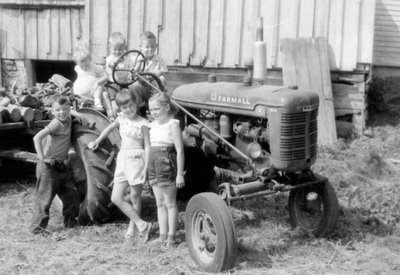
The photo of a mass of grandkids around the tractor pulling a wagon load of wood is the result of one of two very important bees that we had at the farm.
No, not the kind that sting; the kind that share. A bee is a gathering of neighbours to help either thresh the grain or saw the wood.
When trees were cut in the woods, they were hauled out into an empty space and piled up to wait for the sawing bee. The cutting usually took place in the winter when we could get around with horses and sleigh. We lived in a bog, remember. In the spring, the man with the saw and tractor arrived and set up in front of the pile of logs.
The invitation had gone out a few days before, so the neighbours arrived and set to work. It was intense, hard work carrying sixteen-foot logs to the saw and reducing them to sixteen inch blocks. That was only half the job, really. At a later date, someone had to split those blocks into stove sized wood and then move the whole lot into the wood shed in preparation for winter. That is what is happening in the photograph.
The other bee took place in the fall. After the grain had been cut, bound and stooked, the man with the threshing machine and tractor would arrive when it was our turn. The neighbours, usually the same ones, would arrive and the sheaves of grain would be brought to the barn and the threshing machine by horse and wagon.
The straw was blown into a mow in the barn to be used for bedding for the cattle over the winter. The grain was bagged and stacked in the granary to be ground at the water-powered grist mill in Spencerville. Again, it was hard, hot and dusty work.
When noon came, the men all washed at the pump and headed for the house where tables groaned with the weight of the food. And did they eat! My mother, assisted by two or three neighbouring ladies, would serve up the potatoes and meat and vegetables and bread and two kinds of pie and mugs of tea. It all disappeared like magic. Work hard, eat hard.
These farmers had to consume a tremendous number of calories just to keep going. The difficult physical labour required volumes of food, for after the bee is over and the grain is bagged, everyone rushed home to do the chores –milk the cows, feed the hens, clean the barn.
Bees were social occasions as well as socialist concerns. It was self-help and help one another, all on good spirits. Lots of talk, lots of laughs. This ready exchange of labour worked well. The result was a strong community.Pass Them All


Me and My Cars
I have always been interested in cars, and it is easy to see why. My pedal car was my prize possession when I was 5 and my red MGA was my prize when I was 25.
As I was growing up, we could not afford a modern car and had to do with castoffs. I remember my brother Ray arriving late at night in a 1931 Buick. He was in the air force at the time, likely posted to Trenton air base. He returned on the bus leaving the car behind.
We drove that for quite a while, and I say "we", because my father taught me to drive in that car. We would go up Buckwheat Row where there was very little traffic. It was a pretty rough gravel side road. After one such trip with me at the wheel, I remember him saying, "You must be a good driver. Only a good driver could hit all the pot holes."
I remember we graduated to a 1934 Plymouth with so-called suicide doors. Like the Buick, it would not start in the depths of winter and we had to pull it out to the road with the team of horses and drag it in second gear until it started.
After I graduated from University and had an income, I bought a shiny read MGA with chrome wire wheels from George at Cooke-Toledo Motors in Montreal. This was my pride and joy, polished every day. When I pulled into the yard at home, my mother turned up her nose and asked, "What kind of a car is that?" After one ride she was converted to sports cars. She really loved it.
In an MG, you never follow anyone; you pass them all.Fiftieth Anniversary
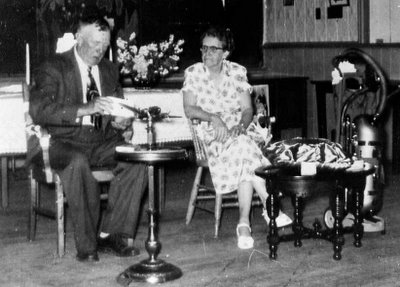
The Groveton community organized a fiftieth wedding anniversary party for my parents. It was held in the school house and everybody came.
Two presents stand out: the vacuum cleaner, which we likely did not have, and the ash tray sporting a twin-engined airplane. This ash tray stand was very popular at that time, and I recall it in the living room for many years afterwards.Inside

One of the very few indoor pictures that I can find shows our mother and father posing in front of the Marconi radio with the electric radio on top. This was obviously taken after the house was wired and someone had a flash camera.
Other farmers will recognize the farmer’s tan on my father –white forehead with the rest burned. This only comes from long hours in the sun wearing a cap.Monday, December 19, 2005
No Electricity
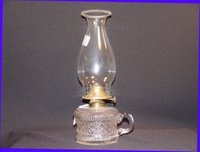

We had no electricity on the farm until after the war. Today it is almost impossible to appreciate the problems that people had due to lack of that magical power. Of course, we had not known anything else, so it didn’t seem strange. But it was hard work!
There are no pictures in the family albums taken inside the house or barn because there was no light there and cameras were fairly primitive by today’s standards. Pictures were taken outside in the sunlight.
We used kerosene lamps for light on those long cold winter nights. These are the lamps that people buy now as backup light at their cottage or just for decoration, for many lamps were beautifully designed. I remember cleaning the black soot from the glass chimney with newspaper when I had reached the age where I would not drop them. We had one Aladdin lamp, which was not magic at all, but it did give a very bright light. Since I was a great reader, this was an important educational tool.
Of course, we heated the house with wood using a cook stove in the kitchen and a Quebec heater in the parlour. There were only two rooms on the main floor of the house and three bedrooms upstairs. Every fall we would fill the wood shed with good hardwood to keep the place warm through those icy winters. There was no furnace or even a fan of any sort to move the warm air around. Coming in from the cold with frozen feet created a close relationship with the stove even to the extent of feet in the oven.
Since cooking was done using wood, having a good hot fire was important. I remember my mother sending me out to get an armload of small maple poles from the wood shed so she could control the heat to the oven so the bread would not fall. In summer, we moved out to the summer kitchen which was airy and cooler than the main house. The cooking still had to be done with wood, but the hot air was exhausted through the large screened windows.
One of the largest problems we had was the cooling of food. Without a refrigerator, we used an ice box. In the winter, we would cut ice from a river and draw it to the ice house by the barn. Buried in saw dust, ice would remain solid all summer. When needed, a block would be uncovered, washed off and placed in the ice box. This worked remarkably well, but there was no freezing available except by renting a locker at the butcher’s in town. That meant a lot of canning took place during the summer.
Of course there were no power tools without electricity, so everything was done by hand from sawing to drilling to pumping water. The Kingston family were great wood and metal workers, so when something had to be constructed we got them to do it in their well-equipped shop just up Buckwheat Row.
We did have a telephone. It was a huge party line with many of our neighbours sharing the service. The telephone was powered by dry cell batteries and to ring someone, you had to crank the handle on the side. Everyone had a different ring, but everyone could hear all of the rings. And when you picked up the receiver, you could hear the conversation going on.
Also, the ring from central in town was stronger because they had electricity and just pushed a button, so when a long distance call came, we knew. So did everyone else. Our ring was two longs, and when by brothers and sisters were away other people would pick up when they heard our ring to get the latest news on the family. The problem with that was that the more receivers that were open the fainter the sound. We had to admonish certain neighbours who were inveterate listeners and ask them to hang up so we could hear George or Ray or whoever. That was not fun. The fun was in listening in on other folks.
Of course we had no television, but we had radio, and this was the golden age of entertainment radio. Amos and Andy, Fibber McGee and Molly, The Green Hornet, Lux Radio Theatre, and the good old CBC. The Marconi sat by the wondow with my father’s rocking chair in front of it. That radio was the centre of attention every evening, although I was not partial to the farm broadcasts at 12:00 noon.
The radio was powered by a car battery that we took into Spencerville and had recharged at the garage while the rest of the shopping was done. It is amazing how resourceful we were in those days before the coming of electricity.
Gathering Sap

I was born in 1934, a period when the Great Depression was just beginning to take its toll in Canada and around the world. It was a time when many businesses went bankrupt and jobs were hard to find. Cash was scarce, but we were very fortunate that we lived on a farm.
Our farm was over 100 acres, a good part of it maple bush and another part cedar swamp. In that one sentence, I have defined the path to survival for a large family like the Hendersons.
Mixed farming meant that we had plenty of food all year round. We milked six cows by hand and sold the milk to the cheese factory. Every morning my father got out of bed around 6 a.m., started the wood fire in the cook stove in the kitchen and went out to the barn. When I was old enough to milk cows, the rest of by brothers and sisters had left home, so he would call for me to get up and help with the chores. Recent research has proven what I knew instinctively –teens need their sleep! I hated getting out of bed.
After the milking was done, the milk was strained into cans, which were set in a water trough at the well pump. We would pump cold water using the hand pump into the trough to cool the milk for shipping. A truck would pick up the cans of milk at the highway and leave us yesterday’s cans. The milk cheque was a major part of the income for the farm. But the milk also meant that the family had lots of milk to drink, fresh and unpasteurized, as well as cream and butter.
Hens produced eggs, pigs produced pork, and beef came from the slaughter of a fat heifer in the fall. Of course we had chicken pot pie on occasion and sold the eggs to the egg grading station, which was also the grocery store. The payment for the eggs went towards paying the bill for groceries. Since we had no electricity, we rented a locker from the butcher in Spencerville and stored the beef, as well as berries and other food, in that commercial freezer.
The huge garden produced great organic vegetables and enough potatoes, carrots and turnips to last the winter. We ate well in a period when men walked in desolation from place to place looking for work. Many a "tramp" stopped to see if he could work for pay or food. No pay was available, but Mother always gave them something to eat.
The other two cash crops that the farm produced were cedar posts and maple syrup. There was an advantage to living in a swamp –cedar trees love it. Farmers from the less swampy areas of Ontario would come and buy the rights to a plot where they would cut cedars for fence posts. Cedar is almost impervious to water and, therefore, make great posts.
The maple sugar bush provided a fairly large influx of cash in March when the sap would run. In the photo you can see my father and I, as a little boy, on the sleigh with the tank for gathering sap from the 900 trees that had been tapped. Gathering sap was a hard job mitigated only by the glorious sunny March days that signalled the trees that it was time to wake up and greet Spring.
We used horses to pull the sleigh through the deep snow in the woods. I remember wading in snow almost to my waist with a sap pail used to empty the buckets on the trees and carry it to the tank. From there the full tank was pulled to the shed where the evaporator steamed. It takes forty gallons of sap to make one gallon of syrup, so a hot fire is required.
My father did the boiling and a hired man gathered the sap. The basic fuel was wood, again from the bush on the farm, but we needed coal added to make the fire really hot. To boil the sap, my father used a large shed that had been used to tie up horses behind a church. The church had disappeared, but the shed remained and served for many years as the sugar shanty. One of its great benefits was that it was right on the highway. People would stop and buy the freshly made syrup by the gallon or by the quart bottle. We used old whiskey bottles, which many people would return to be refilled.
The syrup provided needed cash through the years that my father made it. Spring was a flush period, relatively speaking. Naturally we stored several gallons for family use. My father had a sweet tooth and so there was always a pitcher of maple syrup on the dinner table.
Isn’t it ironic that I and my family grew up eating organic vegetables, free range chicken and uninjected beef, which is premium food now.
Sunday, December 18, 2005
The Barns Are Gone

The satellite picture shows the entire area with Groveton at the cross roads of County Road 44 and Groveton Road to the Ventnor Road where the Cummings lane leads northward to the white dots in the middle of the picture that are the barns and house.
What was a farm in Groveton is now grown up to trees and bush. The house stands, but the barns are gone.Monday, December 12, 2005
The Cummings Family
 My mother was born Margaret Blanche Cummings in Ventnor in 1890. Her parents, George and Eleanor (maiden name Gray) had 8 children.
My mother was born Margaret Blanche Cummings in Ventnor in 1890. Her parents, George and Eleanor (maiden name Gray) had 8 children.
Although I have very little information about them apart from what I remember, I have a picture with all of them in it. This photo was taken in our front yard at the farm on some occasion where everyone is dressed as for church. They are all there and no one else, so the photo was and is special.
In the back row from left to right are Charlie, my mother, Neil, Etta, Sarah, and Ralph with Bell and Etta seated.My sister Dorothy tells me that there was another member of the family, Jerry, who was killed in an accident at age 22. He worked on the railway and was scalded by steam.
All members of this family were born in the farm house on the Ventnor Road. While I was growing up, Charlie was living in the family home with his own family. I remember going out for the cows in the summer and finding them in the pasture at the extreme end of the farm. By looking over the fence, I could see the Cummings house where my mother was born. She was married from there and moved a little more than a mile to live her married life in Groveton. It is remarkable how both my parents were born, lived, loved and died within a ten mile radius.
The other members of the Cummings family also lived quite close to us. I recall visiting them with my mother. Aunt Bell was very strict with little boys. I remember sitting on a straight chair inside the front door with the Eatons’ catalogue to look at. In spite of that experience, I recall my aunts and uncles as warm and inviting.
How did they find each other when they were young? Improbably, my father met my mother at a meeting of The Union Literary Club, which was held at the Island School house on Dukelow Road. I wonder what happened at this Literary Club. Likely the literary part involved the reading of novels, but it also lead to the union of my parents and very likely to other unions as well.
One of the reasons for telling the story of the Hendersons and the Cummings is that, although I knew all of my aunts and uncles and therefore my cousins as well, my own children do not know members of their extended family. All of my aunts and uncles lived within a 10 mile radius, except for Uncle Joe in Syracuse and an Aunt in Vancouver, so we saw them at church and on many other occasions. That is not the case now. I hope my children and theirs will read this account with interest and, if it is long enough, learn about their relatives both past and present.
One of the customs in the rural community that I grew up in was to visit on Sunday afternoons. We had regular visitors who arrived by car to exchange the local gossip and then move on. These were strictly drop in visits with no formal invitations and, as I recall, no food or drink offered, although I am sure there were huge pots of tea around.
It was a closed community in many ways, without the benefit of television and daily newspapers to bring us the "bad" news from all over the world. There was lots of bad news from close around, of course, to keep everyone interested, but a good deal of the chat was of the good-natured sort: weather, crops, the price of eggs.
It was a warm community of people who knew each other well, where everyone had come from, a rooted place. Many young people actually stayed to work on the farm or get a job in the glove factory in Prescott or in a local business. My brothers and sisters left. There were opportunities in the cities and they took them.
But they always came back to visit until there was no family home to come back to. The Cummings family and the Henderson family were combined by our parents. They live on in us.Wednesday, December 07, 2005
Uncle Joe


My father was born in 1887 on a farm on Buckwheat Row to Adam and Rebecca Henderson. He had six brothers and sisters: Joe, Newton, Wilfred, Eliza, Abigail and George.
Newton, or Newt as he was called, was born in 1896. In 1916, at the age of 19 he joined the army. Within the year he was killed in action in Europe. His attestation papers say that he was a farmer and had blue eyes and red hair.
Newt was not the only loss the family suffered. At the age of 26, Wilfrid died of TB. I do not have information about the others, except for Joe.
Of all my father’s siblings, I remember Uncle Joe best. Joseph Byron Henderson was born in Groveton in 1881. At 17, he moved to Syracuse and lived there the rest of his life.
What I recall most about Uncle Joe was his arrival in a big black sedan with his wife Daisy with a big bag of oranges from Florida on the back seat. At a time when there was very little money around, and certainly no oranges except at Christmas, he always seemed to have cash in his pockets for treats. Since he didn’t have any children, he was very generous to me and I am sure to my sisters and brothers. We loved to see him roar into the yard and we ran to see what he had brought this time. The picture on the right shows Aunt Daisy with Dorothy.
I remember driving back from the candy store in Spencerville with him and he showed me how to cut corners on the highway to "straighten out the road." He came quite often, always in the summer time, because he wintered in Miami.
I always imagined that he had a great job that allowed him to own a big car and sport a well-dressed wife. Later I found out that he worked as a bar tender in Syracuse in the summer and at the same job in Miami in the winter.
I think we all loved Uncle Joe best, because of his generosity and his spirit, and because there was a touch of romanticism attached to his life style. He picked up the American accent so that he pronounced "roof" to rhyme with "hoof". We laughed at that. He used to talk about the great American heroes such as Joe Louis and Babe Ruth. "He was a great guy!" he would say.
I wonder why he was called Byron. I don’t suppose he read poetry, but possibly just carrying around the name gave him style and pizzazz.He was a great guy.My Three Sisters

I have three sisters, Dorothy, Madeline and Enid, who grew up on the farm but moved on to careers and family. The second world war opened up a wide range of opportunities for women. Before those years, young women were pretty well restricted to teaching, nursing or homemaking.
When Dorothy chose to become a nurse, she trained at Brockville General for three years to become an RN. She then followed her career in Verdun Protestant Hospital in Verdun, Quebec, until she married Mac and produced Carol and David.
Madeline and Enid both left home to go to work in the Phillips plant in Brockville during the war, taking that opportunity to spread their wings in the wider world.
Madeline married Jim Knox, who was an infantry officer in the Royal Canadian Regiment. Jim was a career soldier and retired as a Colonel, and then contracted to run cadet camps during the summer at Ipperwash. Jim and Madeline had four children, all boys –Doug, Barry, Rickie and Michael. Unfortunately, both Jim and Doug have passed away and are buried in the St. Andrews Presbyterian Church graveyard in Spencerville.
Enid married Malcolm Simpson of Brockville. He too was a service man during the war, serving in the air force. Mac worked in the Phillips plant after the war until his retirement. Their daughter, Joan, lives in Kingston.
My three sisters are all older than I, which, I am sure, gave them lots of chances to practice mothering skills. This latecomer to the family must have seemed like a rare opportunity for them. A baby, a play toy, a pest!
Keep reading. I’m sure they will tell all.Thursday, December 01, 2005
George

When my brother George was born in 1916, he was given the names George after his great grandfather and Newton after his uncle, who was killed at age 19 in the first world war. He was two years younger than Ray, and that made them the best of pals growing up.
In the 40's, George joined the army and served in Canada in the Service Corps, which provides transportation to the other corps, and after the war went across Canada setting up auctions for army vehicles. Many a farmer bought a used army truck or jeep for use on the farm. The picture of George in front of his car is most apt, since he went into the automobile retail business in Toronto and Montreal after the war.
His partner on that cross Canada tour was James Cook, who later became his partner in the imported car business in Toronto. Eventually George started Cook-Toledo Motors in Montreal on St. Catharines Street just a little east of the Forum. He bought this business from Cook, importing British cars: Morris, MG and Jaguar. He sold many a car from there including a bright red MG with chrome wire wheels to me.He later changed to Ford when the British cars became uncompetitive and then GM when he moved the business to Verdun. Every Christmas he would organize a party for all the employees and their families. At first it was held in the show room with Santa and presents for each child of each family. Later he would rent a hall and do it up with decorations and food. There wasn’t a snow storm that would stop the celebration.
He finally sold the business and retired to the Eastern Townships in Knowlton near Lac Brome where he and Barbara had owned a farm for some time.
George and Barbara had four children, compared to Ray’s five and my three –Linda, Elizabeth, Teddy and Judy. In his retirement, he and Barbara have kept fit by playing golf in the summer and curling in the winter.
George has always been a great family man. He came back to the farm where he was born often and, as a successful businessman, delighted in assisting his parents. He also helped me find a job off the farm when I was 18 and later by selling me cars, at the family discount I am sure. He has displayed his generous nature over the years.Tuesday, November 29, 2005
Ray

My oldest brother Ray was quite a guy. As the eldest son he was 20 years older than I and on many issues played the role of father. For example, it was he who suggested that I go to university in 1952, since he had attended Queens after the war to get his BA.
He started out as a teacher, and was, in fact, my first teacher when I turned five. He had attended Ottawa Normal School and started teaching at Groveton P.S. Ray could live at home, of course. I recall him as a very musical person. He was always playing the guitar or accordion or mouth organ and singing songs like Bury Me Out on the Lone Prairie. Before records and CDs and TV, we had to make our own music.
When the war came along, he joined the air force. I remember hearing the roar of an airplane engine and running out of the house to wave at Ray circling over at tree top level in a distinctive yellow Harvard trainer. He was posted at Trenton for some time. He flew Halifax bombers over Germany near the end of the war and, luckily, was not shot down or wounded.
After the war he went to university and then rejoined the air force as an electronics expert with coastal command flying in large radar planes guarding the coastline. He bought a house on the coast just south of Halifax. I recall driving down there in the 50's to visit him and his wife, Shirley, and the kids. I would take Jack and Mary Lyn swimming in the ocean. The Atlantic there is ice cold at the best of times. I could get up to my ankles, but Mary Lyn and Jack would go the whole way in. Ray arranged an exchange with Britain’s coastal command and they lived in London for 2-3 years. I visited them there when I was in Germany for a summer.
When he retired from the air force as a Wing Commander, Ray worked for Ampex for a few years living in Burlington and then in Ottawa. He always complained mightily about the cold winters, and, always one to live up to his principles, moved to Victoria. Eventually, all of the five children moved to BC as if drawn by some magnet. I could never figure that out since my children have a tendency to live all over the globe.
During the war, everyone smoked. It seemed at the time to be one of the greatest of pleasures. Ray was no different, but unfortunately it caught up with him since he died of emphysema at 82. When he left, Shirley and Jack continued to live in the house in Victoria. When I visited last, she had a great party that all of her children came to.
Ray left a large gap in all of our lives because he was a person with an immense energy and an outgoing personality. He meant a great deal to me as the kid brother who he protected and advised well.Monday, November 28, 2005
Dot and Mac
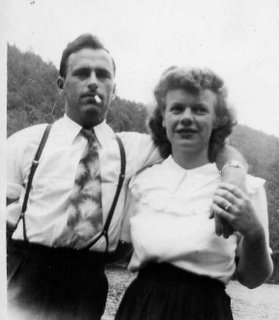
Dorothy surprised us all –not by getting married, but by not telling anyone about it. She arrived late one Friday night in a black 1938 Buick with a handsome dark-haired man who turned out to be none other than her new husband, Ivan MacRae.
Ivan, or Mac as everyone calls him, was in the navy during the war, in the heat of battle as the metal plate in his back will attest to. After the war he worked for a steel company in Montreal until he was transferred to Hamilton.
My sister trained as a nurse and worked at the Verdun Protestant Hospital for many years. After she married Mac, they lived in Verdun until they moved to Waterdown to live with their two young children, Carol and David.
I remember going to their house in Verdun as a 20 something person for a home-cooked meal. Dorothy has always been a great cook and I relished the apple pies and chocolate cake that she turned out. While she cooked, Mac would take me for hair raising drives around the city in the 52 Chevy that replaced the ‘38 Buick. I think he knew every street and road in Verdun and Montreal and, by the way, it is true what they say about Montreal drivers.
At the farm, Mac was a dynamo of activity. Cut that hay! Let’s get it in the barn. My father did not believe in working on Sunday, except for the necessary chores. He would not participate in the Sunday haying, so we took to the fields without him. I tried to object, but could find no grounds. The horses need to rest, I said. So we borrowed a tractor and carried on. It was hot and it was dusty, but we got the hay in! And on a Sunday too.
Dorothy caught a wild one. He makes everyone alive.Sunday, November 27, 2005
My Family

As with all grown families, it was difficult to get ours together in one place, but we did gather on occasion at the farm.
This picture on the lawn of the house shows the family with Ray, Dorothy and George on our mother’s right and Enid, me and Madeline on our father’s left. The photo was taken in the mid 50's.
The farm was the major focal point of the family. Summer drew my siblings back with their kids to help with the hay or bring in the wood for winter. We had many a party in the house with the odd case of beer after my father accepted the fact that his children could drink.
I recall Ivan MacRae arriving with Dorothy from Montreal with beer in the Buick, but it was consumed in the garage, not in the house. Eventually my mother suggested that he could have a beer in the house if he wanted to. It took him a while to accept the invitation.
My parents had a fairly puritanical upbringing where alcohol was concerned but they liked to dance and play cards –square dance, of course, and Euchre with the cards.
My father never drank alcohol until he was introduced to it by his children. It was a sight to see him with a Rye and Coke sipping it and making a face as if it was medicine. He would also finish it as if it was a dose of medicine as well.
I was too young to be included in any of this kind of festivity, of course, but I did get in on the jokes and the raucous laughter that grew out of these gatherings. The gatherings were always good-humoured and we had a lot of fun.Wednesday, November 23, 2005
Groveton School House
 SS#16 was the number of the one room school that we all attended. There are many stories associated with the school, and many will emerge as this memoir develops.
SS#16 was the number of the one room school that we all attended. There are many stories associated with the school, and many will emerge as this memoir develops.
For example, I started to the school school at age 5 and my brother, Ray, was the teacher. I must explain that the school and grounds were across the highway from our house. I stood on my side of the road and envied the kids who always seemed to be playing softball or tag or hide and seek just over there. And I was all alone.
Ray had gone to Ottawa Normal School after graduating from high school and his first job was right across the road from home. Just as well. He could live at home on the pittence they paid teachers in the 30's.
I guess my envy showed, and when I turned 5 on March 3, Ray took me across the road with him into the massive stone building to learn my abc's. It was heaven!Names

Where do all the names come from? My father and mother were humble farmers of land that was rocky and boggy at best. Yet they raised six children before, during and after the Great Depression through iron persistence and hard work, undoubted traits of Scottish Presbyterians.
Both my parents went to elementary shool but no farther, so it is ironic that they met at a book club, one of the social events where guys could meet girls. Married in 1912, they created six children, Ray, George, Dorothy, Madeline, Enid, and after a gap of seven years, me.
And where did the names come from? George is easy, since his great grandfather George brought it all over the ocean from Scotland. The name Ray is problematic, as is Dorothy, Madeline and Enid, fairly unusual names that makes me think that they could have come from novels --remember that book club?
But my name trumps them all: Clare for a boy! I can only think that it was the Irish "Clare" they had in mind, since my grandmother Rebecca McQuade was Irish and she might have had something to do with it.
I have met several male Clares in my life and at one time there were two other Clare Hendersons living in Oakville. We used to get each others' telephone calls --who would think there might be more than one person in town with that name!The Henderson Family

The Story of the Henderson Family is quite remarkable.
It stretches back in time to the south of Scotland when Thomas George Henderson married Janette Storey, on to one of their sons, Adam and his wife Rebecca McQuade, and to William Grover Henderson and Margaret Blanche Cummings, who raised a family on a farm in Groveton, Ontario, Canada.
That is where this Henderson story begins, in a remarkably small farm house where all six children were born, grew up and thrived. There may be other stories like it, but this is ours alone.
Life in a One-Room Schoolhouse

I started school when I was only 4 going on 5, because my brother Ray was the teacher and he took pity on me. I would stand alone at our house and watch the kids playing and having a great deal of fun in the school yard just across the highway. He finally took me by the hand and led me across the road, my start at formal learning.
The school room was set up with the little desks in a row on one side of the space with each row getting larger and larger until the big desks lined the other side of the room. At the front were two blackboards with risers in front of them. The teacher’s desk was there as well. In the very centre was a large wood-burning stove designed to keep the schoolhouse warm in winter. Sometimes it was so cold in January, that we all had to huddle around the stove to keep from freezing.
The school building was built of stone as you can see in the photograph. It had three large windows on each side and two windows at the door end. The other end had a door leading to the huge wood shed that was piled to the roof with split maple to burn in winter. It made a great place to hide during recess when we played hide and seek. Sometimes we would climb in among the piles of wood and block up the hole so we couldn’t be seen. Unfortunately, we always had to appear when the school bell rang to end recess.
The teacher must have been pretty busy with kids from grades one to eight. As each person grew larger they moved to a larger desk, and, presumably, a higher grade. I imagine the teacher grouped kids as much by ability as by age, which was great advantage for kids with ability. One of the great advantages of a one-room school house is that everybody gets to hear all of the lessons. I remember wondering why those big guys didn’t know the answers to the teacher’s questions when they seemed obvious to me. I mean, there’s the map on the wall. Java is right there –that pink island in the Pacific Ocean!
Those were the days of the grade 8 examinations, the entrance to high school. I recall that Keith Somerville and I were the top students in grade 8 and had no trouble passing the examinations, but not everyone passed them because not everyone continued on to high school.
I remember most of my school mates well. In the photo, that is me at the left in front beside Harold Kingston and Keith Somerville. Behind us are Barbara Douglas, Audrey Grue and Rita Kingston. I cannot identify the rest.
Life in the one-room school house had its advantages. You certainly got to know everyone.
Fishing

Where I grew up, fishing mostly meant fishing for mudpout. Mudpout is the local name for a fish that abounds in Southern Ontario, and is also known as bullhead, catfish, barbotte and mud cat.
And the rule of thumb was, "They only bite when the mosquitoes do!"
The equipment was simple, a pole a line, a hook and a can of worms. Of course, a drive to the river was essential, and it had to be at dusk.
Catfish, or mudpout as we called them, live in slow moving, warm water, the kind you find in the small rivers of Southern Ontario. We used to go to branch of the Nation River and toss in the worm. In between slapping the mosquitoes, we would pull in the lines and fill a bucket with fish. People boasted of the number they caught the night before, and under a hundred was a pointless boast.
Mudpout are easy to clean, which includes skinning them. We used to clean them all and fry up a batch in butter. The fillet comes off the bone easily in one piece, and the next boast was about how many you could eat at one sitting.
Fresh mudpout is hard to beat. They are delicious!
Wednesday, December 28, 2005
Strawberry Jam


There is nothing as sweet as wild strawberries.
I remember going picking strawberries in the warm July sun, sitting on the ground and delicately pinching off those tiny berries and dropping them in a small container –my mouth! I used to eat more than I picked, but still the object was to get enough home to fill a strawberry shortcake made with whipped cream from the farm.
This was all before the days of cultivated strawberries, which I have to admit now can be very good indeed, especially in the middle of February in the form of freezer jam or just thawed berries over yogurt or ice cream. In the days before electricity and freezers, it was preserved jam that carried that great taste over into winter.
We used to buy sugar in 100 pound bags and stand them behind the hall door with the 100 pound bag of flour. A lot of preserving went on in the days before refrigerators, all of it stored on shelves in the cellar just across from the bins of potatoes and cabbages. Throughout summer and fall, my mother would spend hours over a hot fire with the preserving kettle steaming away. The results were spectacular.
But of all of the preserved jams and food, the most delicate and the richest was the wild strawberry jam.
Tuesday, December 27, 2005
Voting

When election time comes around now, it makes me recall what people used to say when I was too young to vote. My father (shown here sitting on that '31 Buick) was returning officer for more than one election, the vote taking place in the Groveton school house.
My father was a liberal, as I recall, and I guess my mother was as well. In any case, it was not a topic of much conversation at the table, so they were amicable about it. Not so every couple. "She killed his vote", they would say, when a wife voted opposite to her husband. This was an unpunished crime.
After the votes were counted, people would speculate on who had changed their vote. Everyone knew everyone else so well, that they could count up the votes to see who had switched parties and to check if anyone had killed her husband’s vote.
There is an up side to living in a small, stable community, and a down side, and election day always brought out the interesting side.
Sunday, December 25, 2005
Barry's Pancakes

Madeline and Jim had four sons, two of whom appear in the picture. Doug, the eldest, is on the right side of his grandmother, and Barry is on her left.
Barry, who now lives in Oakville, has been reading this memoir/family history and has his own memories of visiting the farm.
He writes: Grandma Henderson made the best pancakes. I held the record among us kids of 14 eaten at one sitting. I'd like to try to break that record, but you can't get pancakes like that anymore.
Her porridge was delicious too. I still eat oatmeal everyday to keep the cholesterol down, but, when I make it, it tastes like wet cardboard. She used to stir in butter and cream and top it with maple syrup, of course.
I remember drizzling hot maple syrup from the evaporator on the snow and then eating it like candy when it hardened.
It seems most of my memories of visiting the Grandparents’ farm involve food.
Friday, December 23, 2005
Boarding the Teacher

You’ve seen the house where we were all born. It’s small by just about any standards. There were only two rooms on the main floor and only three bedrooms upstairs.
There was, of course, no basement, only a damp cellar with a large cistern for rain water to collect in and the bins for potatoes, carrots, cabbages and other winter food.
I remember picking the potatoes in the fall and dumping them into a wagon box, which was unloaded using a chute that ran from the wagon in through a cellar window to the potato bin. We ate a lot of potatoes!
The cistern was pretty important, since it collected rain water from the roof that we used for washing. It was nice soft water, great for the Saturday night bath, compared to the well water that was so hard it made the soap congeal.
When I grew up, I had a bedroom to myself and we actually had a guest room, but I wondered what happened when all five kids were there –and the teacher, because we boarded the teacher as an income in those hard depression years.
So where did everybody sleep? Well, the teacher had to have a room of her own, so that left two bedrooms. One bedroom was for the boys, of course. There were two double beds in my parents' room, so that took care of two of the girls. That left someone over. Dorothy solved the numbers problem by explaining that she slept at the end of the hall with the foot of her cot in a closet. The family plus the teacher was taken care of in this way.
The photograph shows my sister Madeline wearing the saddle shoes with the teacher standing in front of the Groveton school house door.
Tuesday, December 20, 2005
Bees

The photo of a mass of grandkids around the tractor pulling a wagon load of wood is the result of one of two very important bees that we had at the farm.
No, not the kind that sting; the kind that share. A bee is a gathering of neighbours to help either thresh the grain or saw the wood.
When trees were cut in the woods, they were hauled out into an empty space and piled up to wait for the sawing bee. The cutting usually took place in the winter when we could get around with horses and sleigh. We lived in a bog, remember. In the spring, the man with the saw and tractor arrived and set up in front of the pile of logs.
The invitation had gone out a few days before, so the neighbours arrived and set to work. It was intense, hard work carrying sixteen-foot logs to the saw and reducing them to sixteen inch blocks. That was only half the job, really. At a later date, someone had to split those blocks into stove sized wood and then move the whole lot into the wood shed in preparation for winter. That is what is happening in the photograph.
The other bee took place in the fall. After the grain had been cut, bound and stooked, the man with the threshing machine and tractor would arrive when it was our turn. The neighbours, usually the same ones, would arrive and the sheaves of grain would be brought to the barn and the threshing machine by horse and wagon.
The straw was blown into a mow in the barn to be used for bedding for the cattle over the winter. The grain was bagged and stacked in the granary to be ground at the water-powered grist mill in Spencerville. Again, it was hard, hot and dusty work.
When noon came, the men all washed at the pump and headed for the house where tables groaned with the weight of the food. And did they eat! My mother, assisted by two or three neighbouring ladies, would serve up the potatoes and meat and vegetables and bread and two kinds of pie and mugs of tea. It all disappeared like magic. Work hard, eat hard.
These farmers had to consume a tremendous number of calories just to keep going. The difficult physical labour required volumes of food, for after the bee is over and the grain is bagged, everyone rushed home to do the chores –milk the cows, feed the hens, clean the barn.
Bees were social occasions as well as socialist concerns. It was self-help and help one another, all on good spirits. Lots of talk, lots of laughs. This ready exchange of labour worked well. The result was a strong community.
Pass Them All


Me and My Cars
I have always been interested in cars, and it is easy to see why. My pedal car was my prize possession when I was 5 and my red MGA was my prize when I was 25.
As I was growing up, we could not afford a modern car and had to do with castoffs. I remember my brother Ray arriving late at night in a 1931 Buick. He was in the air force at the time, likely posted to Trenton air base. He returned on the bus leaving the car behind.
We drove that for quite a while, and I say "we", because my father taught me to drive in that car. We would go up Buckwheat Row where there was very little traffic. It was a pretty rough gravel side road. After one such trip with me at the wheel, I remember him saying, "You must be a good driver. Only a good driver could hit all the pot holes."
I remember we graduated to a 1934 Plymouth with so-called suicide doors. Like the Buick, it would not start in the depths of winter and we had to pull it out to the road with the team of horses and drag it in second gear until it started.
After I graduated from University and had an income, I bought a shiny read MGA with chrome wire wheels from George at Cooke-Toledo Motors in Montreal. This was my pride and joy, polished every day. When I pulled into the yard at home, my mother turned up her nose and asked, "What kind of a car is that?" After one ride she was converted to sports cars. She really loved it.
In an MG, you never follow anyone; you pass them all.
Fiftieth Anniversary

The Groveton community organized a fiftieth wedding anniversary party for my parents. It was held in the school house and everybody came.
Two presents stand out: the vacuum cleaner, which we likely did not have, and the ash tray sporting a twin-engined airplane. This ash tray stand was very popular at that time, and I recall it in the living room for many years afterwards.
Inside

One of the very few indoor pictures that I can find shows our mother and father posing in front of the Marconi radio with the electric radio on top. This was obviously taken after the house was wired and someone had a flash camera.
Other farmers will recognize the farmer’s tan on my father –white forehead with the rest burned. This only comes from long hours in the sun wearing a cap.
Monday, December 19, 2005
No Electricity


We had no electricity on the farm until after the war. Today it is almost impossible to appreciate the problems that people had due to lack of that magical power. Of course, we had not known anything else, so it didn’t seem strange. But it was hard work!
There are no pictures in the family albums taken inside the house or barn because there was no light there and cameras were fairly primitive by today’s standards. Pictures were taken outside in the sunlight.
We used kerosene lamps for light on those long cold winter nights. These are the lamps that people buy now as backup light at their cottage or just for decoration, for many lamps were beautifully designed. I remember cleaning the black soot from the glass chimney with newspaper when I had reached the age where I would not drop them. We had one Aladdin lamp, which was not magic at all, but it did give a very bright light. Since I was a great reader, this was an important educational tool.
Of course, we heated the house with wood using a cook stove in the kitchen and a Quebec heater in the parlour. There were only two rooms on the main floor of the house and three bedrooms upstairs. Every fall we would fill the wood shed with good hardwood to keep the place warm through those icy winters. There was no furnace or even a fan of any sort to move the warm air around. Coming in from the cold with frozen feet created a close relationship with the stove even to the extent of feet in the oven.
Since cooking was done using wood, having a good hot fire was important. I remember my mother sending me out to get an armload of small maple poles from the wood shed so she could control the heat to the oven so the bread would not fall. In summer, we moved out to the summer kitchen which was airy and cooler than the main house. The cooking still had to be done with wood, but the hot air was exhausted through the large screened windows.
One of the largest problems we had was the cooling of food. Without a refrigerator, we used an ice box. In the winter, we would cut ice from a river and draw it to the ice house by the barn. Buried in saw dust, ice would remain solid all summer. When needed, a block would be uncovered, washed off and placed in the ice box. This worked remarkably well, but there was no freezing available except by renting a locker at the butcher’s in town. That meant a lot of canning took place during the summer.
Of course there were no power tools without electricity, so everything was done by hand from sawing to drilling to pumping water. The Kingston family were great wood and metal workers, so when something had to be constructed we got them to do it in their well-equipped shop just up Buckwheat Row.
We did have a telephone. It was a huge party line with many of our neighbours sharing the service. The telephone was powered by dry cell batteries and to ring someone, you had to crank the handle on the side. Everyone had a different ring, but everyone could hear all of the rings. And when you picked up the receiver, you could hear the conversation going on.
Also, the ring from central in town was stronger because they had electricity and just pushed a button, so when a long distance call came, we knew. So did everyone else. Our ring was two longs, and when by brothers and sisters were away other people would pick up when they heard our ring to get the latest news on the family. The problem with that was that the more receivers that were open the fainter the sound. We had to admonish certain neighbours who were inveterate listeners and ask them to hang up so we could hear George or Ray or whoever. That was not fun. The fun was in listening in on other folks.
Of course we had no television, but we had radio, and this was the golden age of entertainment radio. Amos and Andy, Fibber McGee and Molly, The Green Hornet, Lux Radio Theatre, and the good old CBC. The Marconi sat by the wondow with my father’s rocking chair in front of it. That radio was the centre of attention every evening, although I was not partial to the farm broadcasts at 12:00 noon.
The radio was powered by a car battery that we took into Spencerville and had recharged at the garage while the rest of the shopping was done. It is amazing how resourceful we were in those days before the coming of electricity.
Gathering Sap

I was born in 1934, a period when the Great Depression was just beginning to take its toll in Canada and around the world. It was a time when many businesses went bankrupt and jobs were hard to find. Cash was scarce, but we were very fortunate that we lived on a farm.
Our farm was over 100 acres, a good part of it maple bush and another part cedar swamp. In that one sentence, I have defined the path to survival for a large family like the Hendersons.
Mixed farming meant that we had plenty of food all year round. We milked six cows by hand and sold the milk to the cheese factory. Every morning my father got out of bed around 6 a.m., started the wood fire in the cook stove in the kitchen and went out to the barn. When I was old enough to milk cows, the rest of by brothers and sisters had left home, so he would call for me to get up and help with the chores. Recent research has proven what I knew instinctively –teens need their sleep! I hated getting out of bed.
After the milking was done, the milk was strained into cans, which were set in a water trough at the well pump. We would pump cold water using the hand pump into the trough to cool the milk for shipping. A truck would pick up the cans of milk at the highway and leave us yesterday’s cans. The milk cheque was a major part of the income for the farm. But the milk also meant that the family had lots of milk to drink, fresh and unpasteurized, as well as cream and butter.
Hens produced eggs, pigs produced pork, and beef came from the slaughter of a fat heifer in the fall. Of course we had chicken pot pie on occasion and sold the eggs to the egg grading station, which was also the grocery store. The payment for the eggs went towards paying the bill for groceries. Since we had no electricity, we rented a locker from the butcher in Spencerville and stored the beef, as well as berries and other food, in that commercial freezer.
The huge garden produced great organic vegetables and enough potatoes, carrots and turnips to last the winter. We ate well in a period when men walked in desolation from place to place looking for work. Many a "tramp" stopped to see if he could work for pay or food. No pay was available, but Mother always gave them something to eat.
The other two cash crops that the farm produced were cedar posts and maple syrup. There was an advantage to living in a swamp –cedar trees love it. Farmers from the less swampy areas of Ontario would come and buy the rights to a plot where they would cut cedars for fence posts. Cedar is almost impervious to water and, therefore, make great posts.
The maple sugar bush provided a fairly large influx of cash in March when the sap would run. In the photo you can see my father and I, as a little boy, on the sleigh with the tank for gathering sap from the 900 trees that had been tapped. Gathering sap was a hard job mitigated only by the glorious sunny March days that signalled the trees that it was time to wake up and greet Spring.
We used horses to pull the sleigh through the deep snow in the woods. I remember wading in snow almost to my waist with a sap pail used to empty the buckets on the trees and carry it to the tank. From there the full tank was pulled to the shed where the evaporator steamed. It takes forty gallons of sap to make one gallon of syrup, so a hot fire is required.
My father did the boiling and a hired man gathered the sap. The basic fuel was wood, again from the bush on the farm, but we needed coal added to make the fire really hot. To boil the sap, my father used a large shed that had been used to tie up horses behind a church. The church had disappeared, but the shed remained and served for many years as the sugar shanty. One of its great benefits was that it was right on the highway. People would stop and buy the freshly made syrup by the gallon or by the quart bottle. We used old whiskey bottles, which many people would return to be refilled.
The syrup provided needed cash through the years that my father made it. Spring was a flush period, relatively speaking. Naturally we stored several gallons for family use. My father had a sweet tooth and so there was always a pitcher of maple syrup on the dinner table.
Isn’t it ironic that I and my family grew up eating organic vegetables, free range chicken and uninjected beef, which is premium food now.
Sunday, December 18, 2005
The Barns Are Gone

The satellite picture shows the entire area with Groveton at the cross roads of County Road 44 and Groveton Road to the Ventnor Road where the Cummings lane leads northward to the white dots in the middle of the picture that are the barns and house.
What was a farm in Groveton is now grown up to trees and bush. The house stands, but the barns are gone.
Monday, December 12, 2005
The Cummings Family
 My mother was born Margaret Blanche Cummings in Ventnor in 1890. Her parents, George and Eleanor (maiden name Gray) had 8 children.
My mother was born Margaret Blanche Cummings in Ventnor in 1890. Her parents, George and Eleanor (maiden name Gray) had 8 children.Although I have very little information about them apart from what I remember, I have a picture with all of them in it. This photo was taken in our front yard at the farm on some occasion where everyone is dressed as for church. They are all there and no one else, so the photo was and is special.
In the back row from left to right are Charlie, my mother, Neil, Etta, Sarah, and Ralph with Bell and Etta seated.
My sister Dorothy tells me that there was another member of the family, Jerry, who was killed in an accident at age 22. He worked on the railway and was scalded by steam.
All members of this family were born in the farm house on the Ventnor Road. While I was growing up, Charlie was living in the family home with his own family. I remember going out for the cows in the summer and finding them in the pasture at the extreme end of the farm. By looking over the fence, I could see the Cummings house where my mother was born. She was married from there and moved a little more than a mile to live her married life in Groveton. It is remarkable how both my parents were born, lived, loved and died within a ten mile radius.
The other members of the Cummings family also lived quite close to us. I recall visiting them with my mother. Aunt Bell was very strict with little boys. I remember sitting on a straight chair inside the front door with the Eatons’ catalogue to look at. In spite of that experience, I recall my aunts and uncles as warm and inviting.
How did they find each other when they were young? Improbably, my father met my mother at a meeting of The Union Literary Club, which was held at the Island School house on Dukelow Road. I wonder what happened at this Literary Club. Likely the literary part involved the reading of novels, but it also lead to the union of my parents and very likely to other unions as well.
One of the reasons for telling the story of the Hendersons and the Cummings is that, although I knew all of my aunts and uncles and therefore my cousins as well, my own children do not know members of their extended family. All of my aunts and uncles lived within a 10 mile radius, except for Uncle Joe in Syracuse and an Aunt in Vancouver, so we saw them at church and on many other occasions. That is not the case now. I hope my children and theirs will read this account with interest and, if it is long enough, learn about their relatives both past and present.
One of the customs in the rural community that I grew up in was to visit on Sunday afternoons. We had regular visitors who arrived by car to exchange the local gossip and then move on. These were strictly drop in visits with no formal invitations and, as I recall, no food or drink offered, although I am sure there were huge pots of tea around.
It was a closed community in many ways, without the benefit of television and daily newspapers to bring us the "bad" news from all over the world. There was lots of bad news from close around, of course, to keep everyone interested, but a good deal of the chat was of the good-natured sort: weather, crops, the price of eggs.
It was a warm community of people who knew each other well, where everyone had come from, a rooted place. Many young people actually stayed to work on the farm or get a job in the glove factory in Prescott or in a local business. My brothers and sisters left. There were opportunities in the cities and they took them.
But they always came back to visit until there was no family home to come back to. The Cummings family and the Henderson family were combined by our parents. They live on in us.
Wednesday, December 07, 2005
Uncle Joe


My father was born in 1887 on a farm on Buckwheat Row to Adam and Rebecca Henderson. He had six brothers and sisters: Joe, Newton, Wilfred, Eliza, Abigail and George.
Newton, or Newt as he was called, was born in 1896. In 1916, at the age of 19 he joined the army. Within the year he was killed in action in Europe. His attestation papers say that he was a farmer and had blue eyes and red hair.
Newt was not the only loss the family suffered. At the age of 26, Wilfrid died of TB. I do not have information about the others, except for Joe.
Of all my father’s siblings, I remember Uncle Joe best. Joseph Byron Henderson was born in Groveton in 1881. At 17, he moved to Syracuse and lived there the rest of his life.
What I recall most about Uncle Joe was his arrival in a big black sedan with his wife Daisy with a big bag of oranges from Florida on the back seat. At a time when there was very little money around, and certainly no oranges except at Christmas, he always seemed to have cash in his pockets for treats. Since he didn’t have any children, he was very generous to me and I am sure to my sisters and brothers. We loved to see him roar into the yard and we ran to see what he had brought this time. The picture on the right shows Aunt Daisy with Dorothy.
I remember driving back from the candy store in Spencerville with him and he showed me how to cut corners on the highway to "straighten out the road." He came quite often, always in the summer time, because he wintered in Miami.
I always imagined that he had a great job that allowed him to own a big car and sport a well-dressed wife. Later I found out that he worked as a bar tender in Syracuse in the summer and at the same job in Miami in the winter.
I think we all loved Uncle Joe best, because of his generosity and his spirit, and because there was a touch of romanticism attached to his life style. He picked up the American accent so that he pronounced "roof" to rhyme with "hoof". We laughed at that. He used to talk about the great American heroes such as Joe Louis and Babe Ruth. "He was a great guy!" he would say.
I wonder why he was called Byron. I don’t suppose he read poetry, but possibly just carrying around the name gave him style and pizzazz.
He was a great guy.
My Three Sisters

I have three sisters, Dorothy, Madeline and Enid, who grew up on the farm but moved on to careers and family. The second world war opened up a wide range of opportunities for women. Before those years, young women were pretty well restricted to teaching, nursing or homemaking.
When Dorothy chose to become a nurse, she trained at Brockville General for three years to become an RN. She then followed her career in Verdun Protestant Hospital in Verdun, Quebec, until she married Mac and produced Carol and David.
Madeline and Enid both left home to go to work in the Phillips plant in Brockville during the war, taking that opportunity to spread their wings in the wider world.
Madeline married Jim Knox, who was an infantry officer in the Royal Canadian Regiment. Jim was a career soldier and retired as a Colonel, and then contracted to run cadet camps during the summer at Ipperwash. Jim and Madeline had four children, all boys –Doug, Barry, Rickie and Michael. Unfortunately, both Jim and Doug have passed away and are buried in the St. Andrews Presbyterian Church graveyard in Spencerville.
Enid married Malcolm Simpson of Brockville. He too was a service man during the war, serving in the air force. Mac worked in the Phillips plant after the war until his retirement. Their daughter, Joan, lives in Kingston.
My three sisters are all older than I, which, I am sure, gave them lots of chances to practice mothering skills. This latecomer to the family must have seemed like a rare opportunity for them. A baby, a play toy, a pest!
Keep reading. I’m sure they will tell all.
Thursday, December 01, 2005
George

When my brother George was born in 1916, he was given the names George after his great grandfather and Newton after his uncle, who was killed at age 19 in the first world war. He was two years younger than Ray, and that made them the best of pals growing up.
In the 40's, George joined the army and served in Canada in the Service Corps, which provides transportation to the other corps, and after the war went across Canada setting up auctions for army vehicles. Many a farmer bought a used army truck or jeep for use on the farm. The picture of George in front of his car is most apt, since he went into the automobile retail business in Toronto and Montreal after the war.
His partner on that cross Canada tour was James Cook, who later became his partner in the imported car business in Toronto. Eventually George started Cook-Toledo Motors in Montreal on St. Catharines Street just a little east of the Forum. He bought this business from Cook, importing British cars: Morris, MG and Jaguar. He sold many a car from there including a bright red MG with chrome wire wheels to me.
He later changed to Ford when the British cars became uncompetitive and then GM when he moved the business to Verdun. Every Christmas he would organize a party for all the employees and their families. At first it was held in the show room with Santa and presents for each child of each family. Later he would rent a hall and do it up with decorations and food. There wasn’t a snow storm that would stop the celebration.
He finally sold the business and retired to the Eastern Townships in Knowlton near Lac Brome where he and Barbara had owned a farm for some time.
He finally sold the business and retired to the Eastern Townships in Knowlton near Lac Brome where he and Barbara had owned a farm for some time.
George and Barbara had four children, compared to Ray’s five and my three –Linda, Elizabeth, Teddy and Judy. In his retirement, he and Barbara have kept fit by playing golf in the summer and curling in the winter.
George has always been a great family man. He came back to the farm where he was born often and, as a successful businessman, delighted in assisting his parents. He also helped me find a job off the farm when I was 18 and later by selling me cars, at the family discount I am sure. He has displayed his generous nature over the years.
Tuesday, November 29, 2005
Ray

My oldest brother Ray was quite a guy. As the eldest son he was 20 years older than I and on many issues played the role of father. For example, it was he who suggested that I go to university in 1952, since he had attended Queens after the war to get his BA.
He started out as a teacher, and was, in fact, my first teacher when I turned five. He had attended Ottawa Normal School and started teaching at Groveton P.S. Ray could live at home, of course. I recall him as a very musical person. He was always playing the guitar or accordion or mouth organ and singing songs like Bury Me Out on the Lone Prairie. Before records and CDs and TV, we had to make our own music.
When the war came along, he joined the air force. I remember hearing the roar of an airplane engine and running out of the house to wave at Ray circling over at tree top level in a distinctive yellow Harvard trainer. He was posted at Trenton for some time. He flew Halifax bombers over Germany near the end of the war and, luckily, was not shot down or wounded.
After the war he went to university and then rejoined the air force as an electronics expert with coastal command flying in large radar planes guarding the coastline. He bought a house on the coast just south of Halifax. I recall driving down there in the 50's to visit him and his wife, Shirley, and the kids. I would take Jack and Mary Lyn swimming in the ocean. The Atlantic there is ice cold at the best of times. I could get up to my ankles, but Mary Lyn and Jack would go the whole way in. Ray arranged an exchange with Britain’s coastal command and they lived in London for 2-3 years. I visited them there when I was in Germany for a summer.
When he retired from the air force as a Wing Commander, Ray worked for Ampex for a few years living in Burlington and then in Ottawa. He always complained mightily about the cold winters, and, always one to live up to his principles, moved to Victoria. Eventually, all of the five children moved to BC as if drawn by some magnet. I could never figure that out since my children have a tendency to live all over the globe.
During the war, everyone smoked. It seemed at the time to be one of the greatest of pleasures. Ray was no different, but unfortunately it caught up with him since he died of emphysema at 82. When he left, Shirley and Jack continued to live in the house in Victoria. When I visited last, she had a great party that all of her children came to.
Ray left a large gap in all of our lives because he was a person with an immense energy and an outgoing personality. He meant a great deal to me as the kid brother who he protected and advised well.
Monday, November 28, 2005
Dot and Mac

Dorothy surprised us all –not by getting married, but by not telling anyone about it. She arrived late one Friday night in a black 1938 Buick with a handsome dark-haired man who turned out to be none other than her new husband, Ivan MacRae.
Ivan, or Mac as everyone calls him, was in the navy during the war, in the heat of battle as the metal plate in his back will attest to. After the war he worked for a steel company in Montreal until he was transferred to Hamilton.
My sister trained as a nurse and worked at the Verdun Protestant Hospital for many years. After she married Mac, they lived in Verdun until they moved to Waterdown to live with their two young children, Carol and David.
I remember going to their house in Verdun as a 20 something person for a home-cooked meal. Dorothy has always been a great cook and I relished the apple pies and chocolate cake that she turned out. While she cooked, Mac would take me for hair raising drives around the city in the 52 Chevy that replaced the ‘38 Buick. I think he knew every street and road in Verdun and Montreal and, by the way, it is true what they say about Montreal drivers.
At the farm, Mac was a dynamo of activity. Cut that hay! Let’s get it in the barn. My father did not believe in working on Sunday, except for the necessary chores. He would not participate in the Sunday haying, so we took to the fields without him. I tried to object, but could find no grounds. The horses need to rest, I said. So we borrowed a tractor and carried on. It was hot and it was dusty, but we got the hay in! And on a Sunday too.
Dorothy caught a wild one. He makes everyone alive.
Sunday, November 27, 2005
My Family

As with all grown families, it was difficult to get ours together in one place, but we did gather on occasion at the farm.
This picture on the lawn of the house shows the family with Ray, Dorothy and George on our mother’s right and Enid, me and Madeline on our father’s left. The photo was taken in the mid 50's.
The farm was the major focal point of the family. Summer drew my siblings back with their kids to help with the hay or bring in the wood for winter. We had many a party in the house with the odd case of beer after my father accepted the fact that his children could drink.
I recall Ivan MacRae arriving with Dorothy from Montreal with beer in the Buick, but it was consumed in the garage, not in the house. Eventually my mother suggested that he could have a beer in the house if he wanted to. It took him a while to accept the invitation.
My parents had a fairly puritanical upbringing where alcohol was concerned but they liked to dance and play cards –square dance, of course, and Euchre with the cards.
My father never drank alcohol until he was introduced to it by his children. It was a sight to see him with a Rye and Coke sipping it and making a face as if it was medicine. He would also finish it as if it was a dose of medicine as well.
I was too young to be included in any of this kind of festivity, of course, but I did get in on the jokes and the raucous laughter that grew out of these gatherings. The gatherings were always good-humoured and we had a lot of fun.
Wednesday, November 23, 2005
Groveton School House
 SS#16 was the number of the one room school that we all attended. There are many stories associated with the school, and many will emerge as this memoir develops.
SS#16 was the number of the one room school that we all attended. There are many stories associated with the school, and many will emerge as this memoir develops.For example, I started to the school school at age 5 and my brother, Ray, was the teacher. I must explain that the school and grounds were across the highway from our house. I stood on my side of the road and envied the kids who always seemed to be playing softball or tag or hide and seek just over there. And I was all alone.
Ray had gone to Ottawa Normal School after graduating from high school and his first job was right across the road from home. Just as well. He could live at home on the pittence they paid teachers in the 30's.
I guess my envy showed, and when I turned 5 on March 3, Ray took me across the road with him into the massive stone building to learn my abc's. It was heaven!
Names

Where do all the names come from? My father and mother were humble farmers of land that was rocky and boggy at best. Yet they raised six children before, during and after the Great Depression through iron persistence and hard work, undoubted traits of Scottish Presbyterians.
Both my parents went to elementary shool but no farther, so it is ironic that they met at a book club, one of the social events where guys could meet girls. Married in 1912, they created six children, Ray, George, Dorothy, Madeline, Enid, and after a gap of seven years, me.
And where did the names come from? George is easy, since his great grandfather George brought it all over the ocean from Scotland. The name Ray is problematic, as is Dorothy, Madeline and Enid, fairly unusual names that makes me think that they could have come from novels --remember that book club?
But my name trumps them all: Clare for a boy! I can only think that it was the Irish "Clare" they had in mind, since my grandmother Rebecca McQuade was Irish and she might have had something to do with it.
I have met several male Clares in my life and at one time there were two other Clare Hendersons living in Oakville. We used to get each others' telephone calls --who would think there might be more than one person in town with that name!
The Henderson Family

The Story of the Henderson Family is quite remarkable.
It stretches back in time to the south of Scotland when Thomas George Henderson married Janette Storey, on to one of their sons, Adam and his wife Rebecca McQuade, and to William Grover Henderson and Margaret Blanche Cummings, who raised a family on a farm in Groveton, Ontario, Canada.
That is where this Henderson story begins, in a remarkably small farm house where all six children were born, grew up and thrived. There may be other stories like it, but this is ours alone.




